18. A COLD WAR DEVELOPS

THE COLD WAR INTENSIFIES
CONTENTS
 The Berlin Blockade (1948-1949) The Berlin Blockade (1948-1949)
 The creation of NATO The creation of NATO
 Nuclear deterrence Nuclear deterrence
 The Korean War (1950-1953) The Korean War (1950-1953)
The textual material on page below is drawn directly from my work
A Moral History of Western Society © 2024, Volume Two, pages 248-254.
THE BERLIN BLOCKADE (1948-1949) |
It
was gradually coming to Stalin the idea that his wartime Allies
Britain, France and America were not viewing their presence in Germany,
and especially in Berlin, as temporary … but were planning to stay
there until all of Germany could be reunited and then – and only then –
the occupying powers would depart. And the situation was worsened
in the eyes of Stalin when pressures he put on the West's occupation of
Berlin (in his sector after all!) by stopping the deliverance of food
items to Berlin were countered by the stopping of the surrender of
German machinery from the Western zones of Germany to the
Russians. Worse, all indications were that the Berlin municipal
elections coming up would not be beneficial to the Communists, who were
rapidly losing support among the Berliners.
Then in early 1948, the three Western powers were clearly making plans
to unite their zones into a single German political unit, with its own
German currency … in preparation to bringing it into the Marshall
Plan. Stalin reacted (April 1948) by shutting down the West's
access by way of rail, highway and canal from what was beginning to be
termed "West Germany" to the Western-held zones of Berlin.
He had, however, no way of stopping flights into Germany without
crossing a very dangerous political line … and thus the Western powers
began to fly needed food and material into Berlin. Thus – for a
while – the Soviets backed down somewhat on the effort to blockade
Berlin. But with the introduction of the new German Mark – in
Berlin as well as in the West – Stalin was so angered that he once
again (June) shut down all access – except, again, by air – into West
Berlin.
He could not stop the flights. But the operation was very
expensive and could not possibly last long – or so Stalin
believed. But he miscalculated greatly Truman's resolve to defend
West Berlin as a symbol of the West's strong determination not to be
beaten into submission by an aggressive Stalin.
Indeed, Stalin had given the West a grand opportunity to demonstrate
its enormous muscle … even bringing into Berlin by way of non-stop
flights the coal needed to get Berlin through one of its hard
winters. Indeed, so thrilled by this display of Western resolve
were the Berliners that the December 1948 West Berlin elections led to
a complete victory of the pro-Western candidates.1
Of course the Communists responded by setting up their own Berlin
municipal government in the Soviet Eastern sector of the city.
Berlin would therefore be a deeply divided city for the next 40 years
(although movement between the two sectors would continue – until the
building of the Berlin Wall in 1961).
But it was a huge loss politically for Stalin. It closed tightly
the ranks of the Americans, British and French as Cold War
allies. And it helped the Germans to see these three powers not
as their occupiers but as their liberators. And it pushed ahead
the creation of a very pro-Western German Federal Republic ("West
Germany") in May of the next year (1949).
This in turn signaled the willingness of the Soviets to end the
blockade … deeply aware that politically their blockade had cost them
badly. So the blockade came to an end. But just in case,
the Allies continued to fly more supplies into West Berlin … a 3-month
reserve just to make the status of West Berlin very clear to the
Soviets.
1The
Social Democratic Party (Socialists) - 64.5%; The Christian Democratic
Union (Conservatives) - 19.4%; the Free Democratic Party (Liberals) -
16.1%. The Communists, who called themselves the Socialist Unity
Party, boycotted the elections.

The city of Berlin is located entirely within the designated Soviet occupation zone
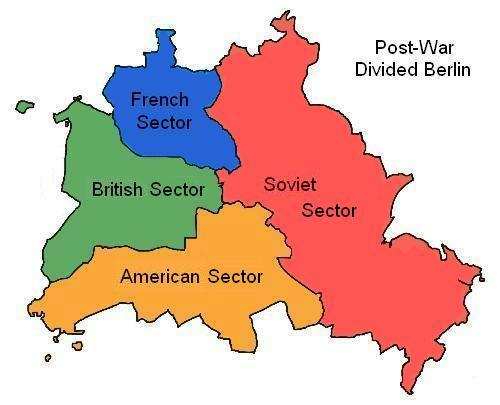
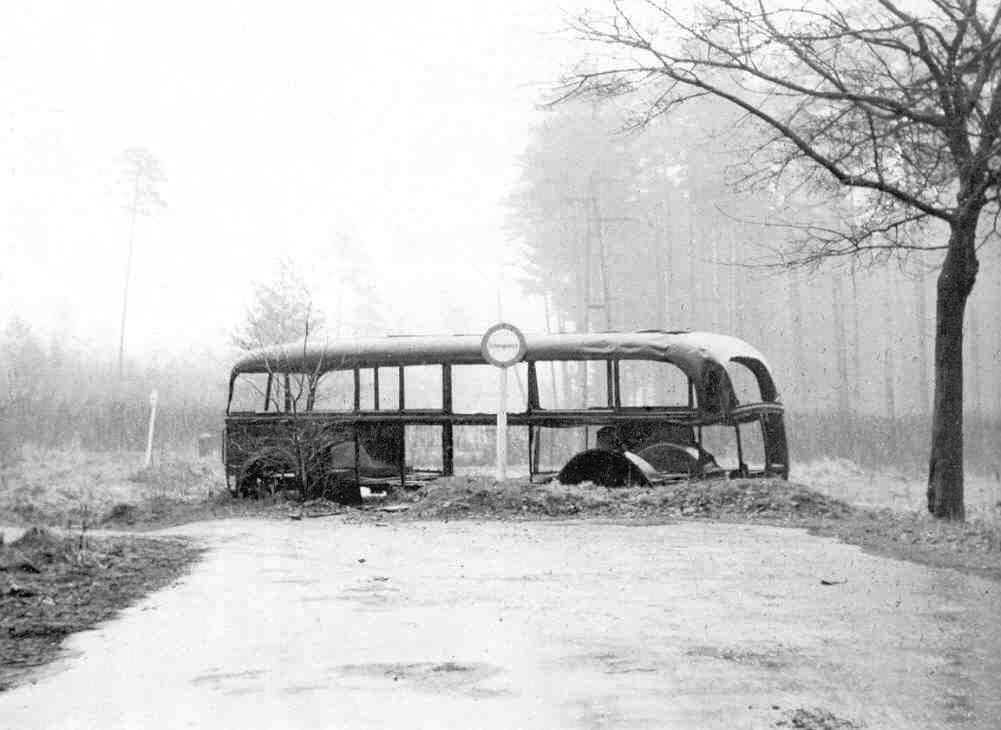
A bus used as a roadblock
across a major highway from the West into Berlin
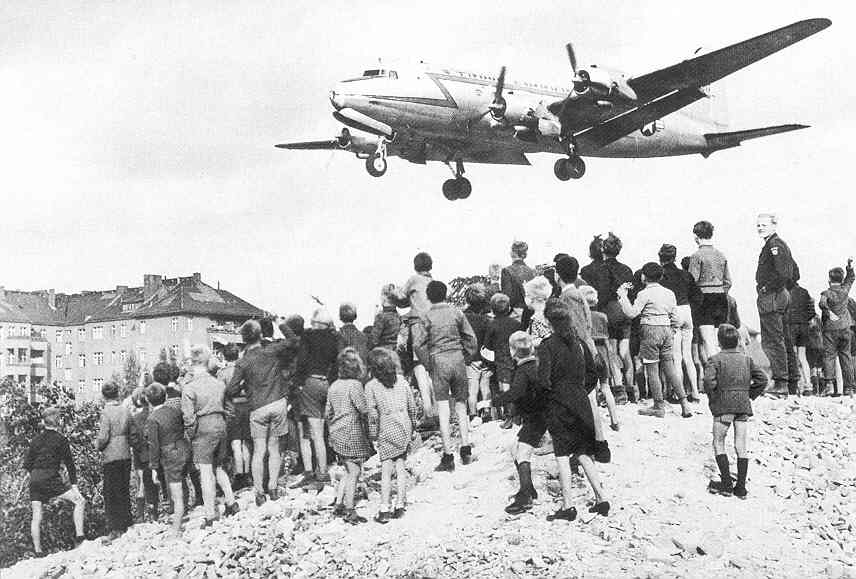
The Berlin Airlift – 1948 - 1949
United States Air Force
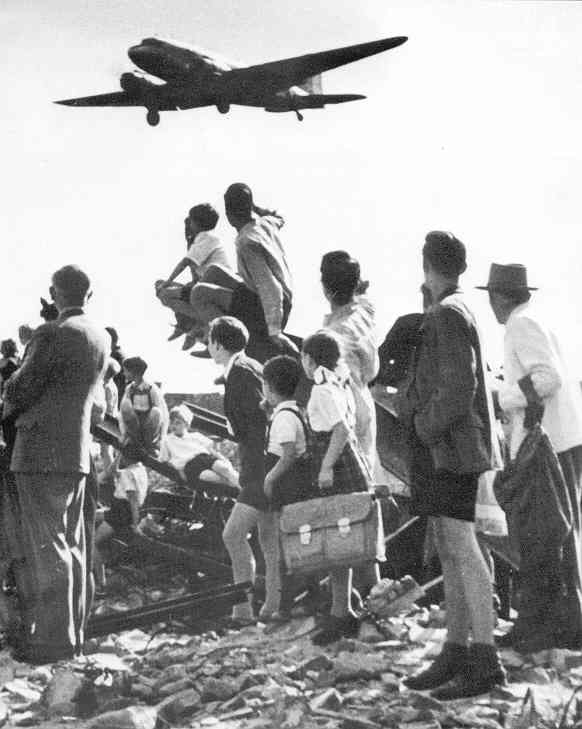 The Berlin Airlift – 1948
- 1949
The Berlin Airlift – 1948
- 1949
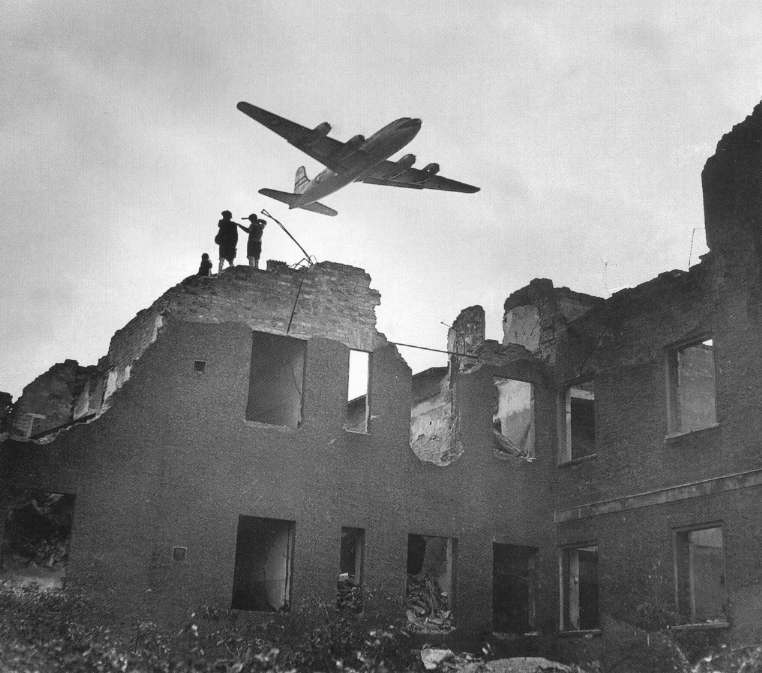
US planes airlifting supplies
into Berlin during the blockade of the city by Stalin
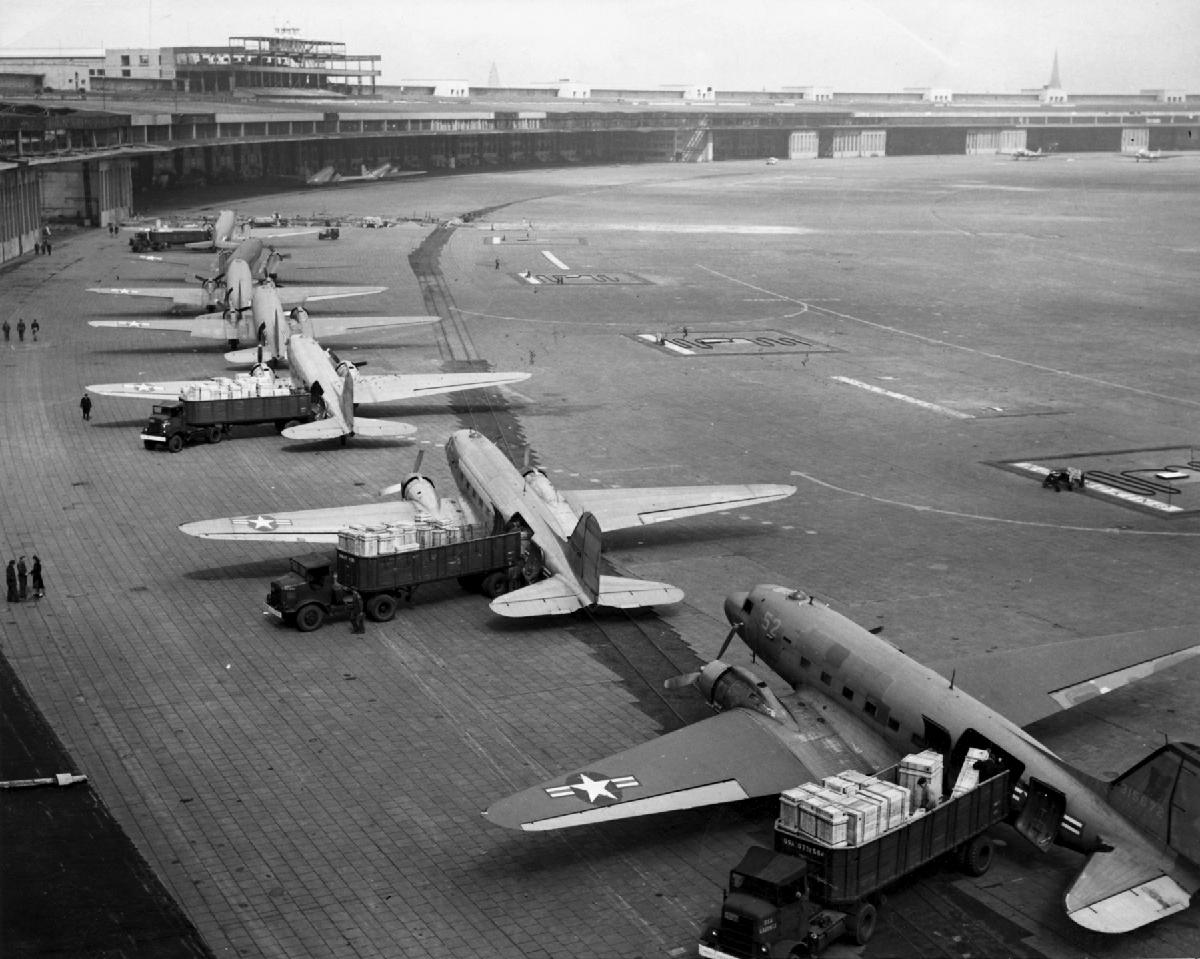
Unloading US planes at Templehof
in Berlin
United States Air
Force
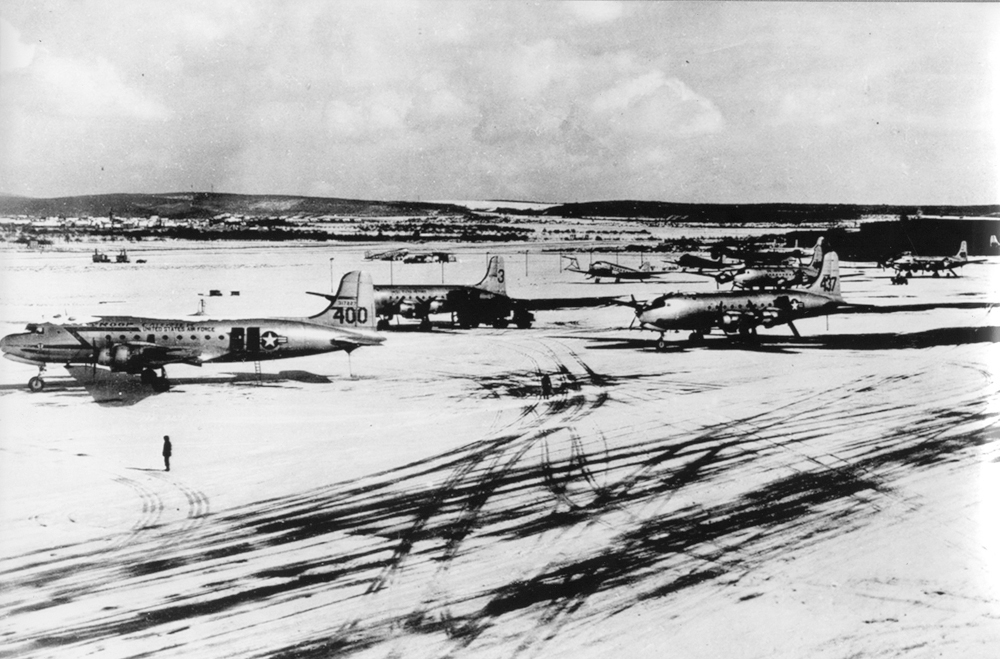
US C-54 cargo planes at snow-covered
Wiesbaden Air Base during the Berlin airlift – March
1949
United States
Army
At
this point the division of the world into two political sectors, "East"
and "West," made it clear that no amount of diplomacy was going to
resolve this rising Cold War. The United Nations itself was
divided accordingly … and thus of no use in promoting the dream of
world peace that Roosevelt had felt would come into being with this
institution finding itself in place at the heart of the world's
doings. The divisive ideology – backed up with massive military
muscle (including atomic weapons … which the Soviets themselves finally
attained in August of 1949) – put this rivalry beyond the realm of
reasoned diplomacy … much like the two world wars earlier that century.
Since military muscle rather than persuasive diplomacy reigned at the
heart of the Cold War, it was rather inevitable that the Western
powers, mostly demilitarized since the end of World War Two because of
a general animosity toward more military infighting, saw the need to do
something about the fact that a huge military establishment faced them
– and their rights as free people – in the hostile form of the huge
Soviet military buildup in the East. They would need something
big to counter this Soviet challenge facing them (Czechoslovakia and
Berlin had greatly awakened them to this danger). Their own
national armies were hardly up to the task.
Thus on April 4th, 1949, diplomats of twelve "Western" nations2 met in
Washington to sign the North Atlantic Treaty … uniting them in such a
way that an attack on any one of them was an attack on them all.
And because America was part (actually the key part) of this
arrangement, these nations felt that they had provided themselves a
quite sufficient response to the Soviet challenge.
Actually, the British, French, Dutch, Belgians and Luxembourgers had
already put together a military pact (The Treaty of Brussels) in March
of 1948 … although it was motived by a fear of a revived Germany as
much as it was of the Soviet threat further East. They even went
so far as to set up a joint military command structure, the Western
Union Defense Organization.
The new North Atlantic Treaty was an amazing "peacetime" step for
Americans out of their former isolationism. But a combination of
the Czech Communist coup, the Berlin Blockade, and the distinct change
in early 1948 of the Republican Chairman of the Senate Foreign
Relations Committee, Arthur Vandenburg, from isolationist to
internationalist, all served to push that American transition
ahead. Indeed, it was the Vandenberg Resolution of June 1948,
approved in the Senate 82-13, that opened the way for just that
American resolve to see to the defense of a "Free West."
Then when in 1950 the Korean War broke out, the new Alliance saw the
need to push ahead (like the Western Union Defense Organization) and
form a joint military command structure – now termed the North Atlantic
Treaty Organization (NATO) … bringing together 35 military divisions
under the new NATO Supreme Commander, Gen. Eisenhower – working out of
the France-based Supreme Headquarters of the Allied Powers of Europe
(SHAPE) … itself headed up by Churchill's primary wartime military
assistant, Lord Hastings Ismay, who would serve as NATO's Secretary
General (1952-1957).
2America, Canada, Iceland, Great Britain, Norway, Denmark, Portugal, Italy, France, Belgium, the Netherlands, and Luxembourg.
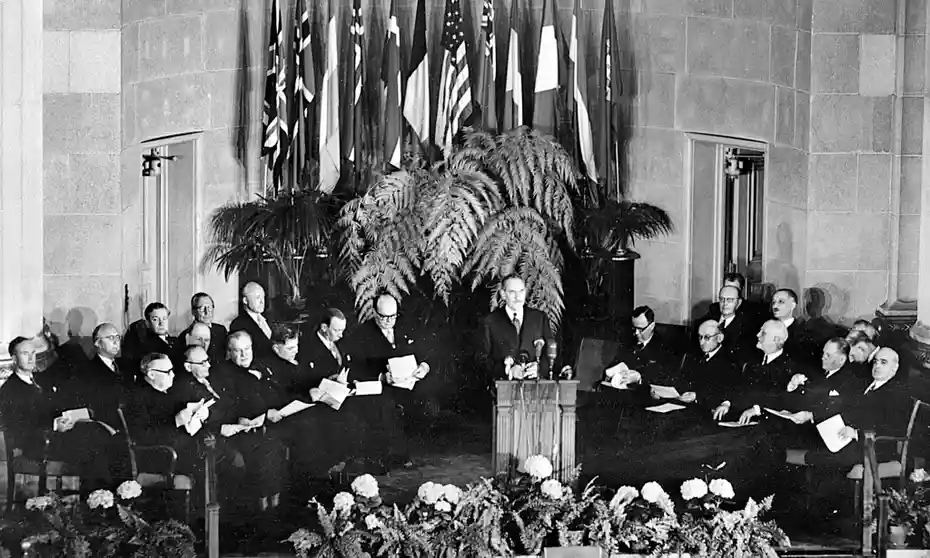
The Foreign Minister of 12 Western nations assembled to sign the North Atlantic Treaty with Dean Acheson at the podium at the State Department - April 4, 1949
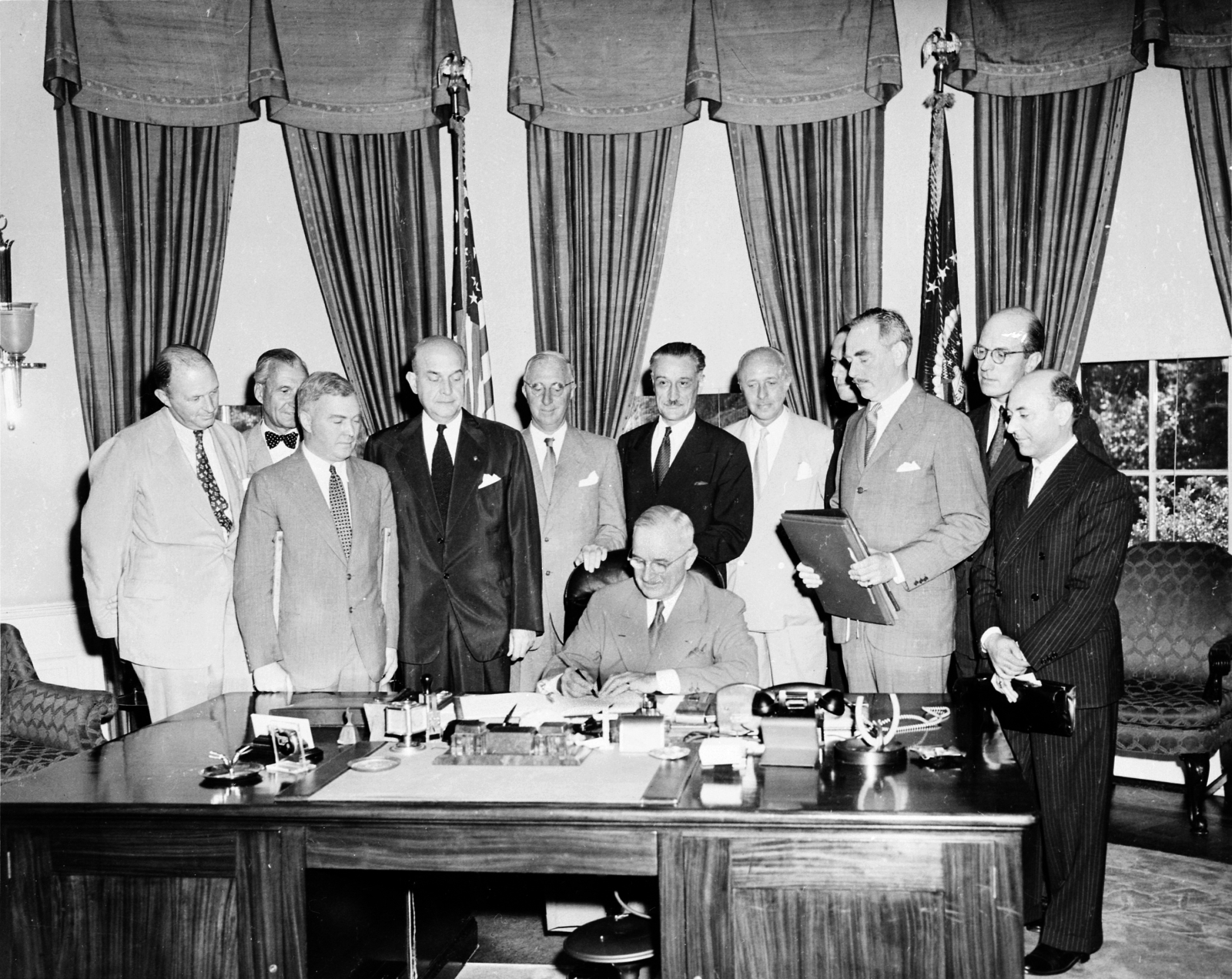
Truman signing the North Atlantic Treaty Proclamation - August 24, 1949
following the Senate's ratification of the Treaty and the President's own signing earlier (July)
... with diplomats from Britain, Denmark, Canada Norway, France,
Portugal, Netherlands and Italy looking on
Backing
up the threat of American retaliation – something that undercut deeply
Stalin's ability simply to use his huge military shadow thrown over
Eastern Europe to intimidate Western Europe – was always the implicit
threat of the use of nuclear weapons such as America used against Japan
in 1945. The possession of these awesome weapons – and the
willingness of American President Truman to actually use them, as he
clearly demonstrated in the conflict with the Japanese – gave America
and its Western allies a strong sense of security when contemplating
trouble with any new rising power wanting to take over the world.
But when in 1949 the Soviets exploded their own atomic bomb, the
nuclear threat now worked both against as well as for American
power. American attitudes about the bomb went directly from happy
confidence to terrible fear as Americans realized that atomic weapons
could now be used on them.
|

American A-Bomb Test - 1946
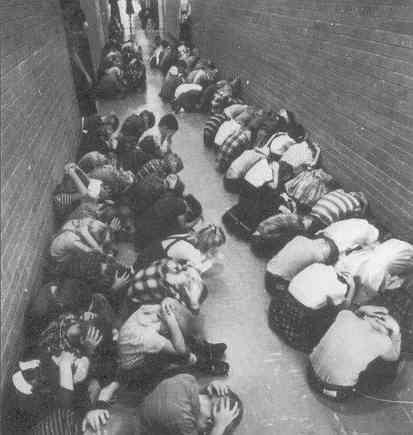 Air raid drill at
school
Air raid drill at
school
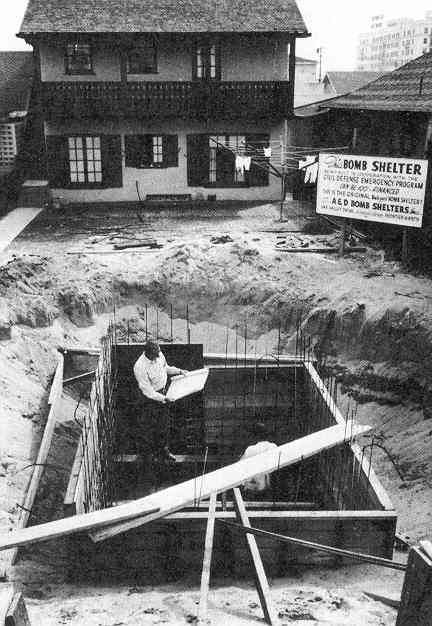
Building a backyard bomb
shelter in Hermosa Beach, California - 1951
|
The
post-war North-South division
Initially, as the Cold War first
developed, Korea was not a country that factored greatly in American
strategic thinking. In fact, a speech by American Secretary of
State Dean Acheson (January 1950), in detailing America's zone of
interest in Asia, did not even mention Korea. But that was about
to change.
At the end of World War Two, Japanese-occupied Korea (annexed to the
Empire of Japan in 1910) was demilitarized under the supervision of
both America and Russia … Stalin getting jurisdiction in the northern
half of the country (part of the sweetener offered Stalin by Roosevelt
at Yalta to get Russia to join America in its war against Japan), with
America seeing to the demilitarization of the southern half … Korea
thus "temporarily" divided equally North and South at the 38th
parallel.
But the Koreans themselves were very divided on this matter of this
Soviet-American arrangement and in 1946 took to the streets in protest
… some supportive, some opposed (yes, there were pro-Communists in the
South as well as many pro-democracy Koreans in the North). Thus
America, distracted by events developing in Europe, simply decided in
1947 to turn the matter over to the U.N. … and call for elections to
unite the country the following year. But when election time
came, the Soviets claimed that the northern half of the country was not
ready for elections … and thus the 1948 elections were held only in the
South. There the conservative politician Syngman Rhee was
the winner – someone that the Americans were not wild about – but
willing to offer support to nonetheless.
But surprisingly, the Korean north found itself "now ready" for such an
election … only months after blocking the U.N. elections in the
North! And there the Communists were majorly victorious.
The Communist politician Kim Il-sung won handily, on the promise that
he would confiscate all the lands owned by Korea's small aristocracy …
and turn them over to the peasants as their own property.3
In short, Korea was now divided into two distinct societies, with very
different governments ruling in the North and in the South.
America protested. But there was little it could do. The
leverage that America once held in its nuclear monopoly was now gone
due to the Soviets being able to match that achievement themselves now.
Worse, and quite unknown to the Americans, the Soviets had been
training a very well-equipped and quite massive North Korean Army in
preparation for a move to "unify" all of Korea under Kim Il-sung.
And rightly so, Kim expected the task to be accomplished fairly easily
… for the South Korean Army was poorly trained and even more poorly
equipped. And Kim planned the move to be a total surprise …
probably allowing his troops to complete the task in a matter of only a
few weeks, perhaps even days.
3Of course, once securely in power, Kim would follow the Soviet model and "collective" all that property … turning ownership over to his Socialist state and transforming Korean peasants into true Communist "laborers." This of course was also the course that Mao took in China.
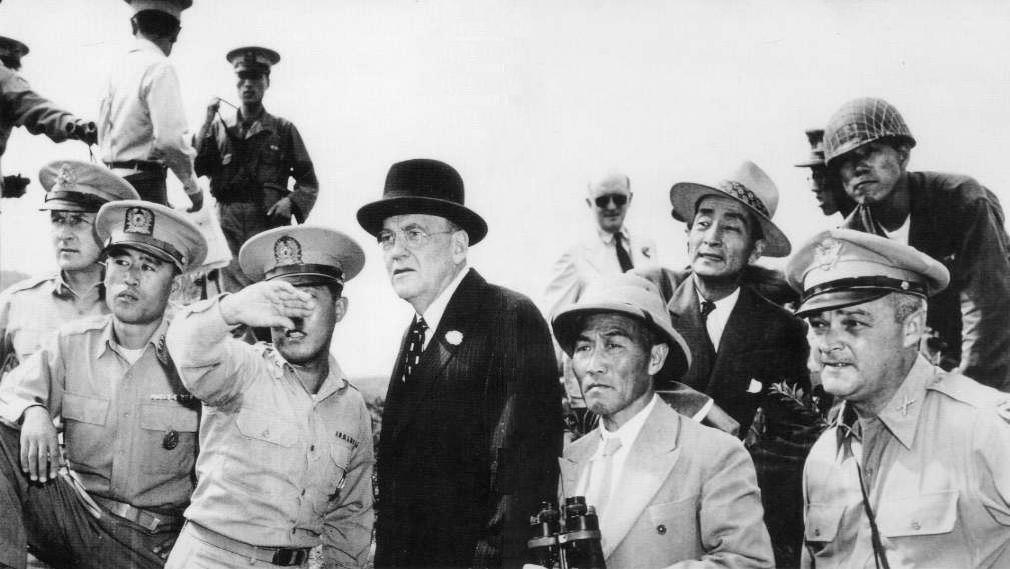 John Foster Dulles being
shown the 38th parallel in Korea - June 17. 1950 (just prior to the North
Korean invasion of the South)
John Foster Dulles being
shown the 38th parallel in Korea - June 17. 1950 (just prior to the North
Korean invasion of the South)
John Foster Dulles Papers,
Princeton University Library
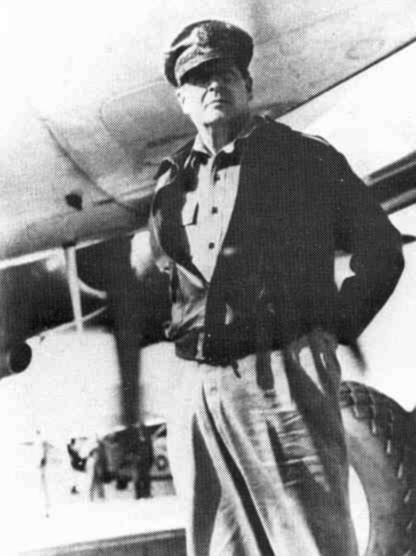 General Douglas MacArthur
– leading the UN forces in Korea
General Douglas MacArthur
– leading the UN forces in Korea
Library of
Congress
|
The
war breaks out (1950)
He almost achieved his goal, when on June 25,
1950 – without any warning - a huge number of North Korean troops
invaded the South … quickly capturing the capital city of Seoul (just
immediately below the North-South border) and then flooding South.
They equally quickly scattered the ill-prepared South Korean forces –
reducing their numbers from 95,000 down to about 22,000 (most simply
fled … or even joined the North Korean forces).
But, seeing the danger that a Communist victory in Korea would pose to
the region around the North China Sea, Truman was just as quick to
respond. He immediately took the matter to the U.N. Security Council …
which the Russians had been boycotting, since the West had blocked the
effort to turn the vital China seat on the Security Council over to
Mao's government. Thus the Russians were not there to issue yet
another veto against U.N. action. Quickly the Security Council moved
to bring military support to the UN-sponsored South Korean government …
and Truman was already answering that authorization with the rapid
movement of troops from neighboring Japan to South Korea.
But it took some effort of those American troops, joined by a small
number of British and other troops, to slow up and then stop the North
Korean momentum. But finally, in early August, they brought the
invasion to a halt … with only the region around the port city of Busan
still in what was now termed "U.N." military hands.
The situation at this point was tricky for everyone. Since it was not
just America defending the South but the U.N. itself, Stalin found
himself unwilling to authorize direct Soviet Russian action against
those U.N. forces. For Mao's China and Kim's North Korea this posed
something of the same diplomatic problem … which China resolved by also
staying out of the matter (for the time being). But North Korea was
caught in a bind … not able or willing to retreat, because to do so
would count as a huge political shaming of Kim's regime. So, the North
Koreans fought on.
|
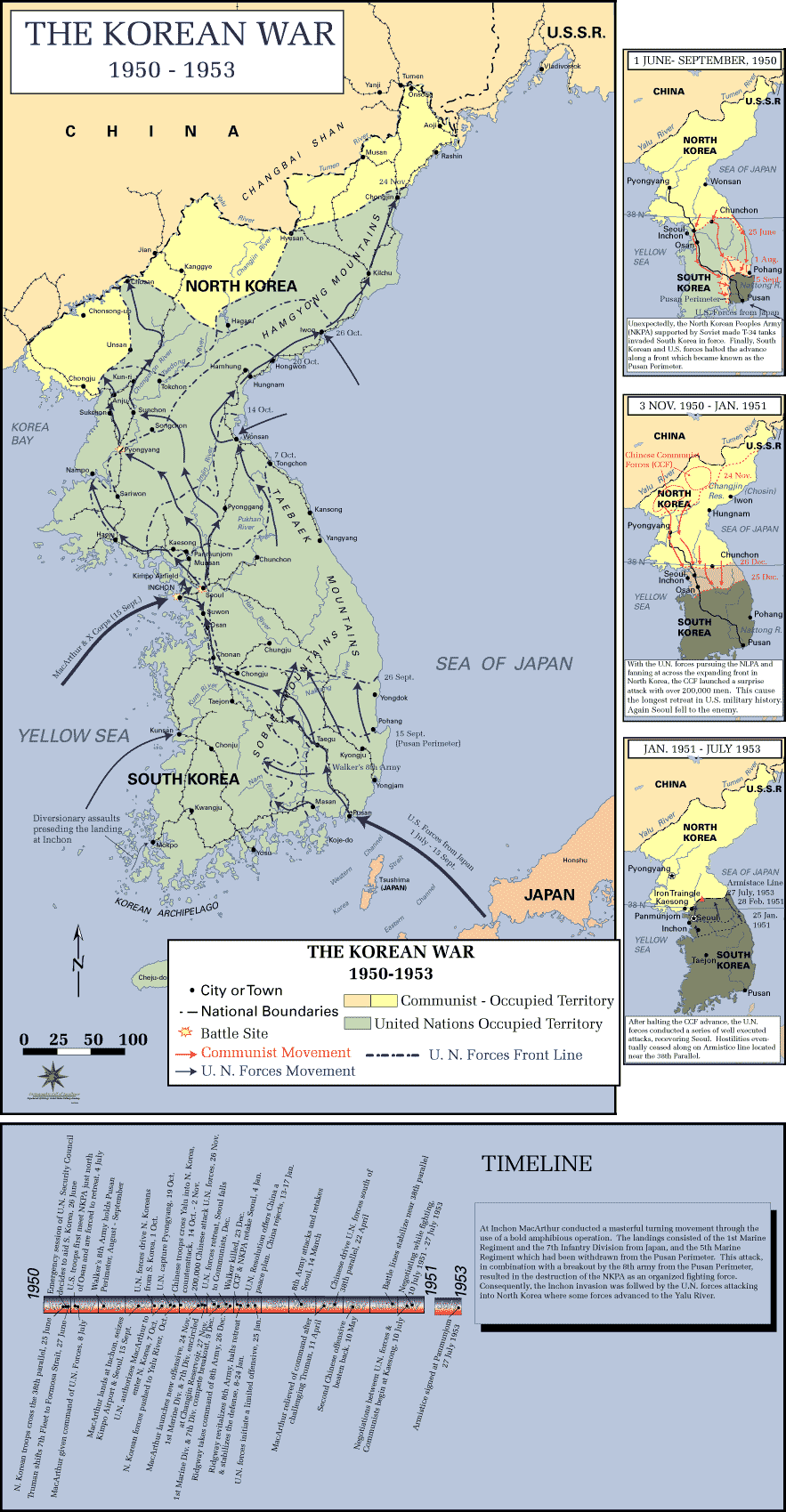
Wikipedia
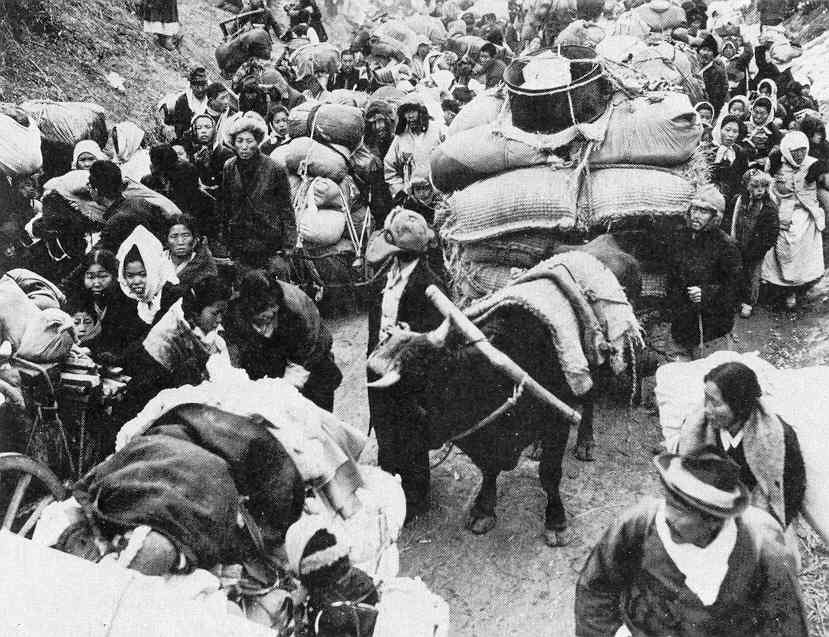 Koreans fleeing the
fighting
Koreans fleeing the
fighting
United Nations (US
Army)
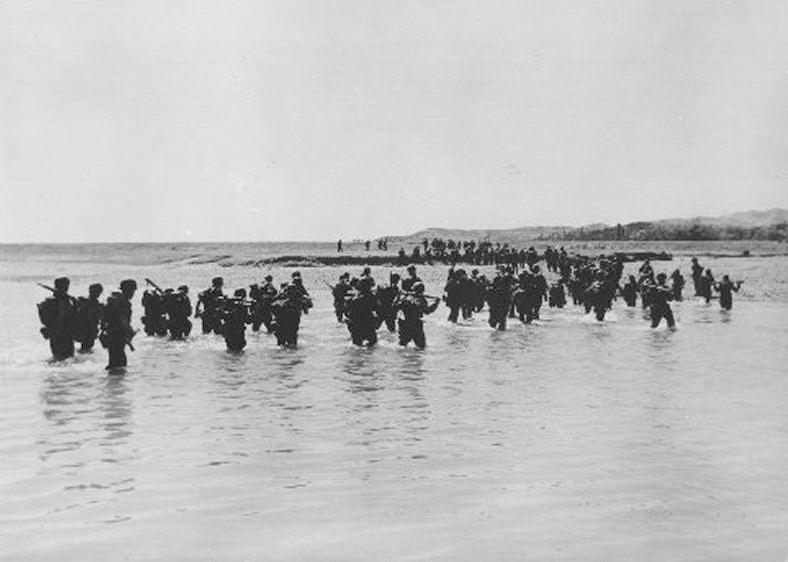 Men of the 1st Cav Div go
ashore somewhere in Korea, 18 July 50.
Men of the 1st Cav Div go
ashore somewhere in Korea, 18 July 50.
United States Army
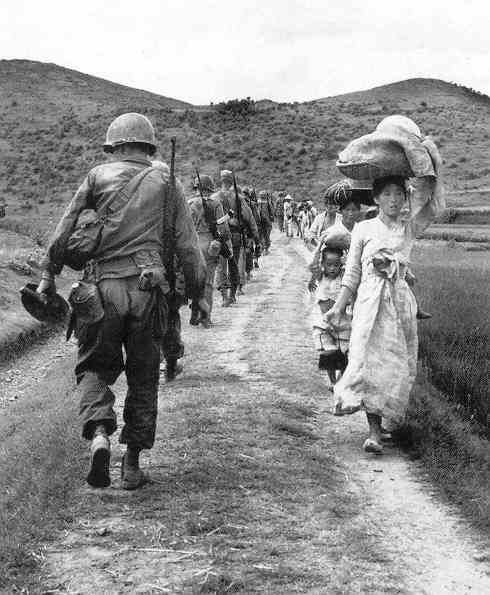 GI's advancing to the action;
Koreans civilians fleeing the action – August 1950
GI's advancing to the action;
Koreans civilians fleeing the action – August 1950
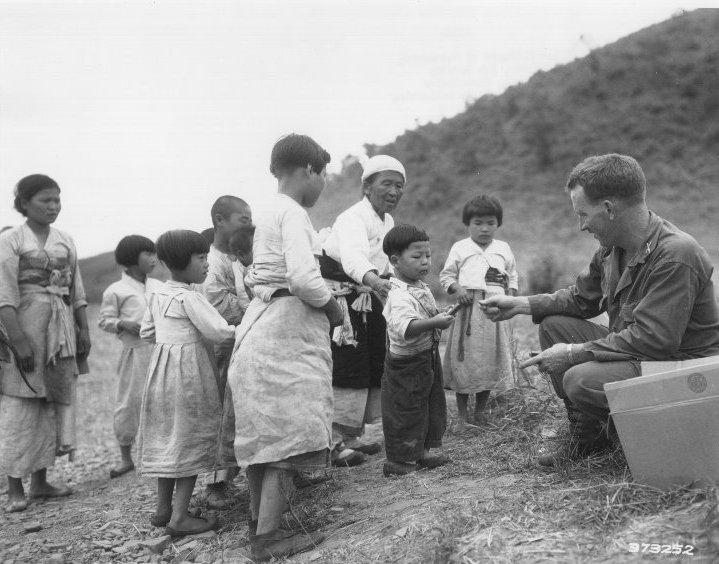 1st LT William Millward of
Baltimore, Md, Civil Assistance Officer, 5th Cavalry Regiment,
1st
Cavalry Division, distributes candy to Korean
children at a refugee Collecting Point
in Western Korea.
1st LT William Millward of
Baltimore, Md, Civil Assistance Officer, 5th Cavalry Regiment,
1st
Cavalry Division, distributes candy to Korean
children at a refugee Collecting Point
in Western Korea.
United States Army
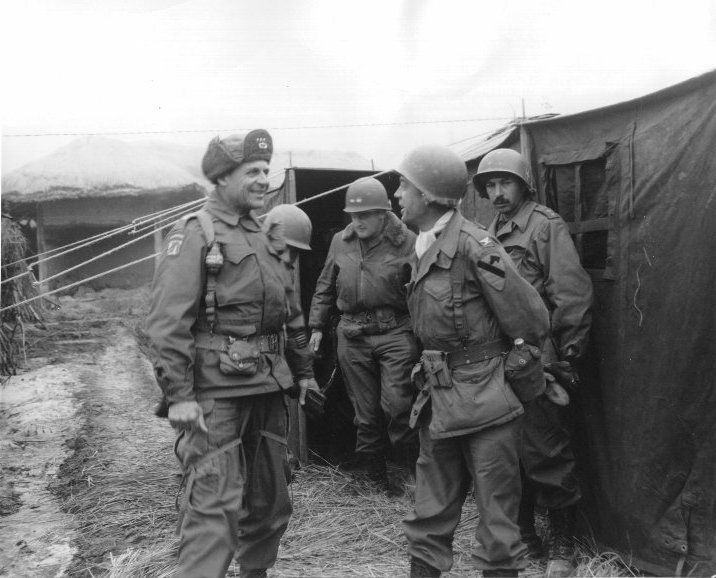 Conferring at Chipyong-ni,
Korea, during General Ridgway's tour of the fighting front, are L-R: LT GEN Matthew Ridgway,
CG US Eighth Army; MAJ GEN Charles Palmer, CG, 1st Cav Div; COL John Daskalopoules,
CO, 7th Cav Regt, 1st Cav. Division
Conferring at Chipyong-ni,
Korea, during General Ridgway's tour of the fighting front, are L-R: LT GEN Matthew Ridgway,
CG US Eighth Army; MAJ GEN Charles Palmer, CG, 1st Cav Div; COL John Daskalopoules,
CO, 7th Cav Regt, 1st Cav. Division
United States Army
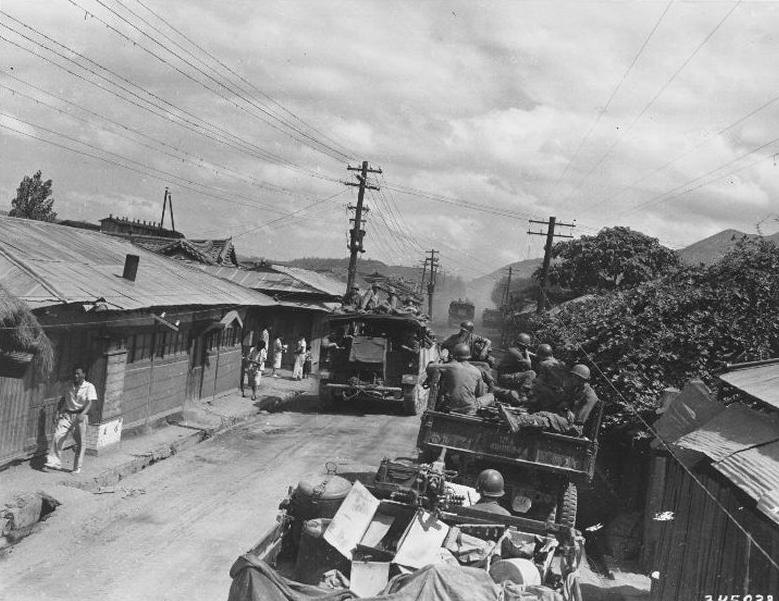 Vehicles of the 1st Cavalry
Division move up to the front lines, somewhere in Korea, 3 Aug 1950
Vehicles of the 1st Cavalry
Division move up to the front lines, somewhere in Korea, 3 Aug 1950
United States Army
|
The landing at Inchon and the North Korean retreat
But the situation was
just as tricky for the U.N. troops … which were finding that coming up
against a North Korean enemy well entrenched in the mountains of the
Korean interior posed the same serious problem that the advance against
Nazi troops in mountainous Italy had recently posed. Thus once again it
was decided to launch a sea landing of U.N. troops on the Korean shores
well to the North of the present line of battle (September 15) … and
then swing them behind the North Korean troops.
But this time, unlike
the stupid delay that took place at the Italian beach at Anzio,
American Gen. MacArthur moved his 75,000 American troops immediately
off the beaches they had secured and had them quickly headed to the
lightly defended interior well above the North Korean Army … which at
this point, fearing entrapment, panicked and fell into rapid retreat.
Seoul was soon liberated after a vicious battle … and then (October 1st) the U.N. and
South Korean (ROK or Republic of Korea) troops crossed the 38th
parallel and headed into North Korea ... despite a Chinese warning not
to do so. Two weeks later the North Korean capital at Pyongyang was
taken … along with 135,000 North Korean troops.
|
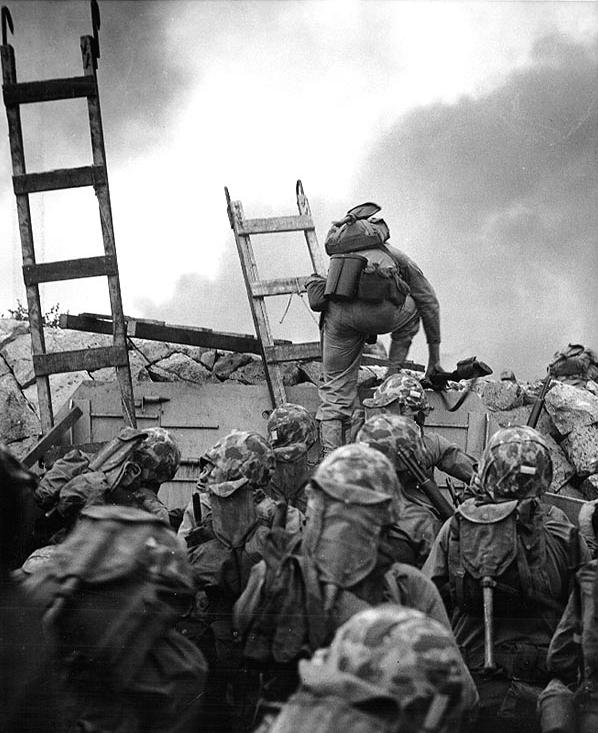
Soldiers Climbing Sea Wall
in Inchon - September 15, 1950. The Battle of Inchon (code
name: Operation Chromite)
was a decisive invasion and battle during the
Korean War.
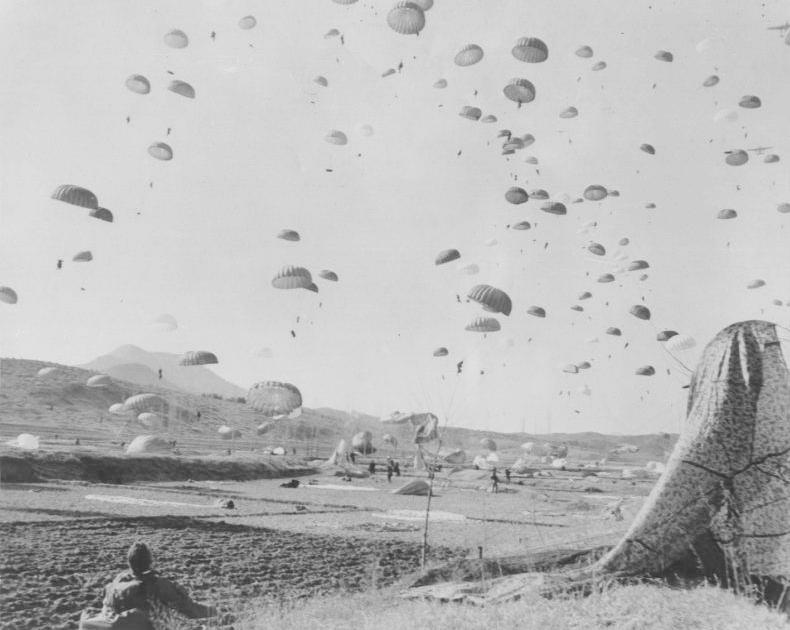 Paratroopers of the 187th
A/B BCT float earthward near Munsan, Korea.
Paratroopers of the 187th
A/B BCT float earthward near Munsan, Korea.
United States Army
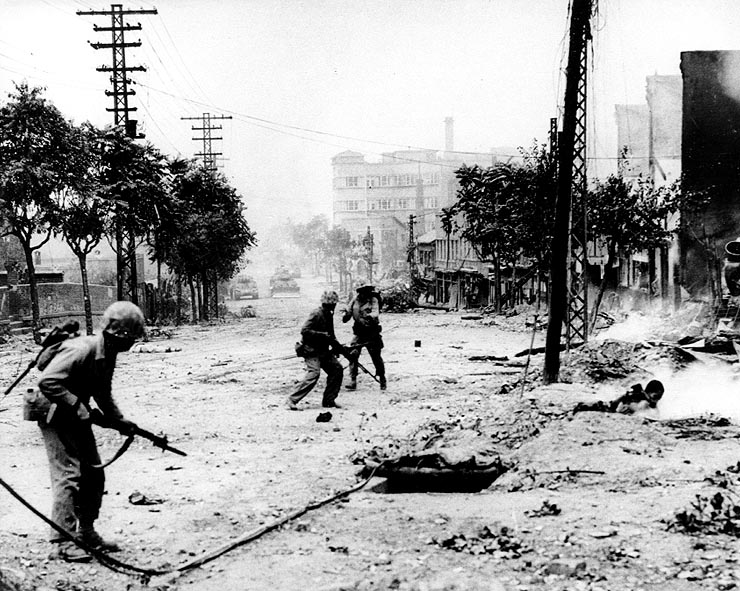 U.S. Marines fighting in
Seoul, Korea, Sept. 1950
U.S. Marines fighting in
Seoul, Korea, Sept. 1950
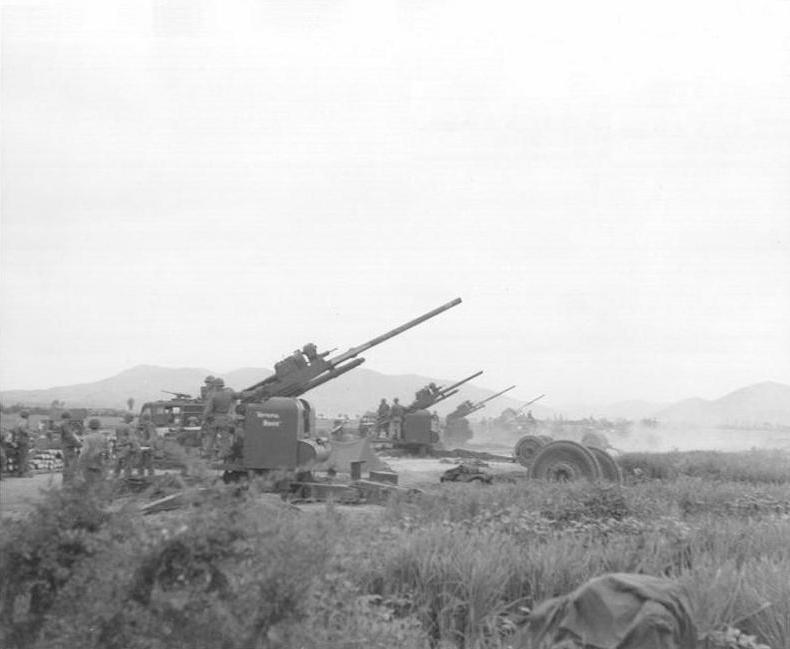
Troops manning 90mm guns,
supporting the 5th Regimental Combat Team, 1st Cav Division,\
on the Taegu
front lines, \ready to lay down a barrage
on the Communist led North Korean as \
UN Forces attack.
United States Army
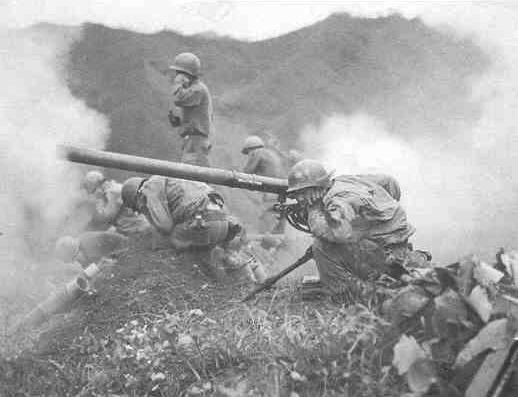 U.N. artillery in
Korea.
U.N. artillery in
Korea.
U.S. Department of
Defense
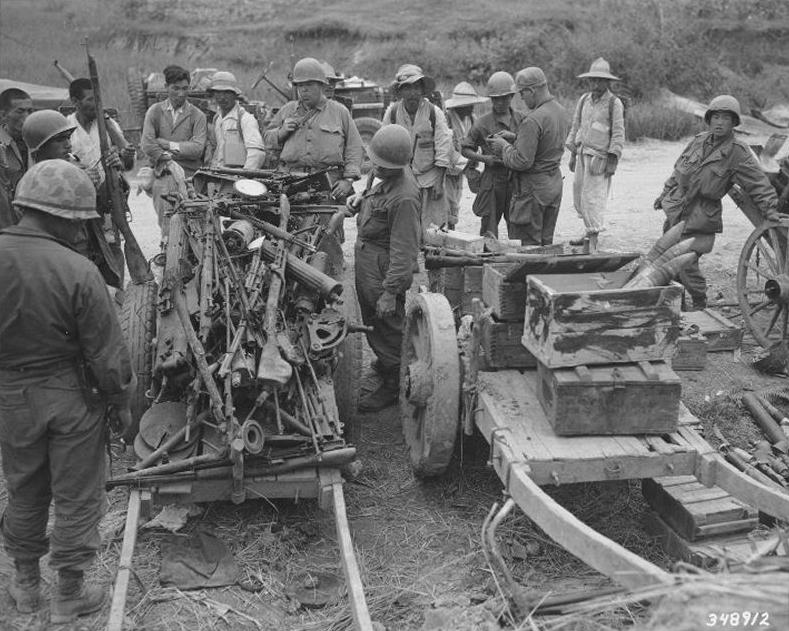
Equipment captured from the
North Koreans is examined by men of the 5th Cavalry Regiment,
Waegwan,
Korea.
United States Army
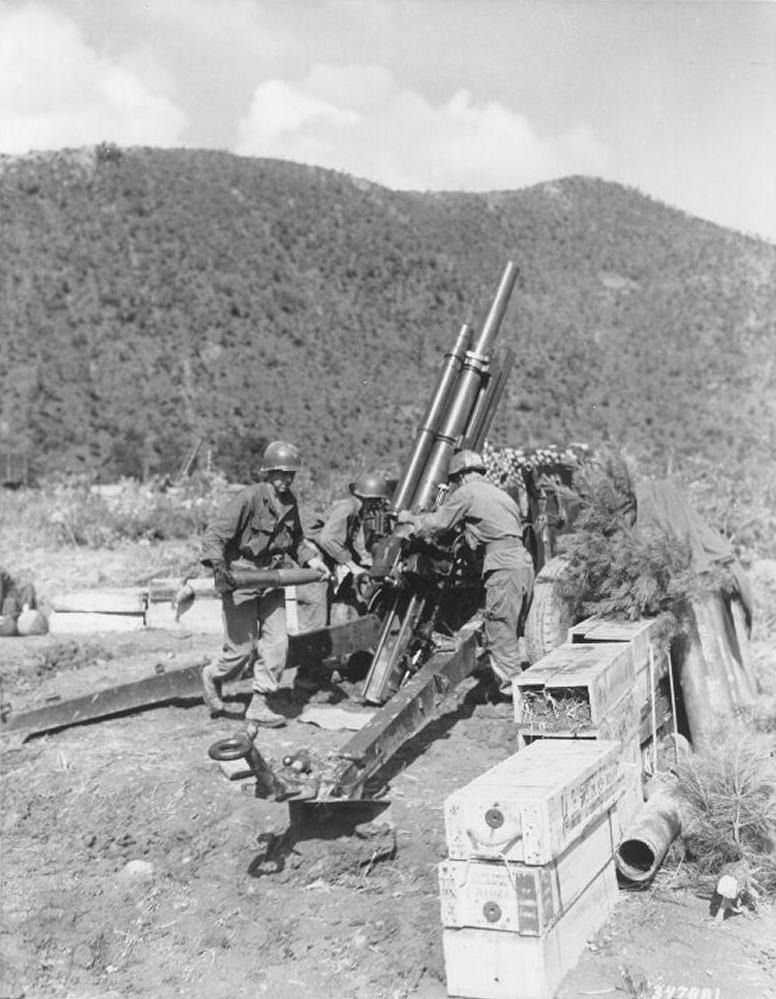 Gun crew of a 105mm howitzer
in action along the 1st Cavalry Division sector
of the Korean battle front.
Gun crew of a 105mm howitzer
in action along the 1st Cavalry Division sector
of the Korean battle front.
United States Army
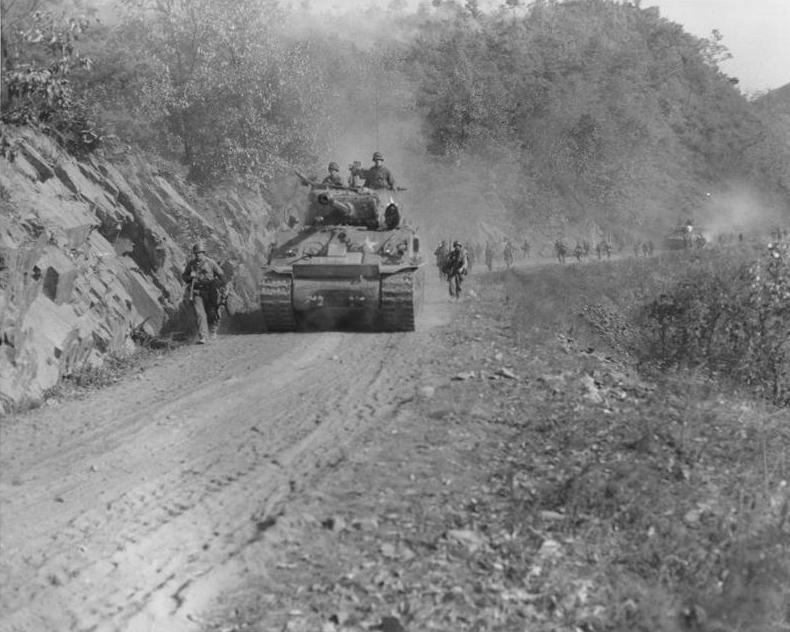
Tanks and infantrymen of
the 1st Cav Division pursue Communist led North Korean Forces approximately 14 miles north
of Kaesong, Korea.
United States Army
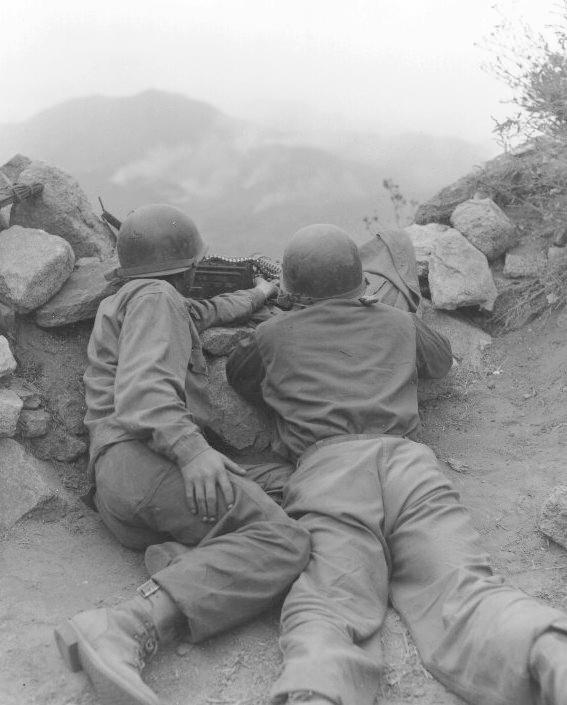
CPL George D. Smedley of
Mt. Vemon, Ind (L) and SGT Thomas P. Montana of Yuma, Ariz, light machine
gun crew members
of Co C, 8th Cav
Regt, 1st Cav Div, watch for Communist-led North Koreans troops on the
38th parallel line, northwest
of Kaesong.
United States Army
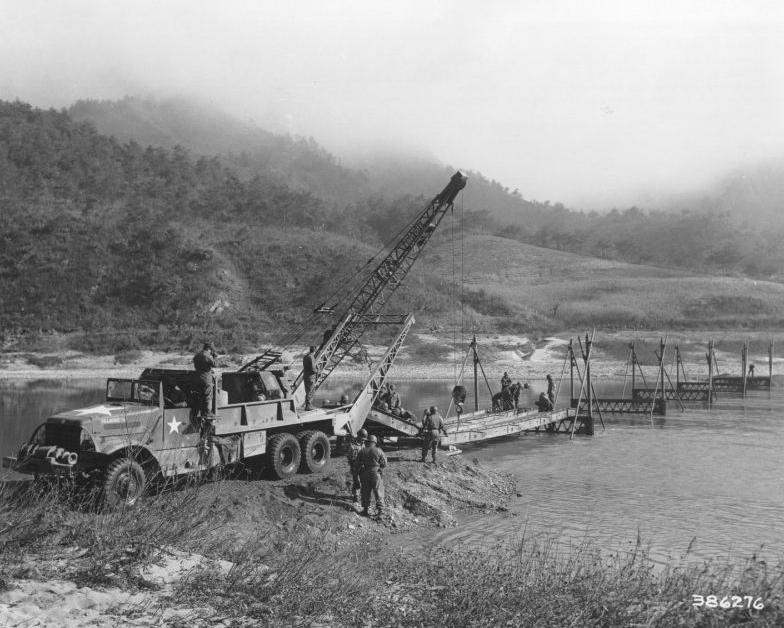
Personnel of the 378th Engineer
Combat Battalion, Eighth US Army, attached to the IX Corps, install treadways during
the construction of a bridge.
United States Army
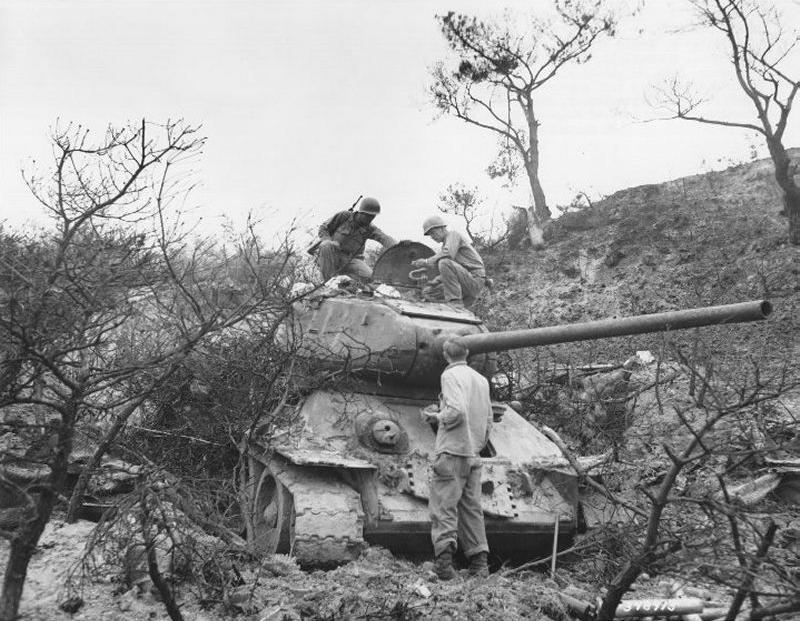 Yanks examine a Soviet-built
tank captured from the North Korean forces, Waegwan, Korea.
Yanks examine a Soviet-built
tank captured from the North Korean forces, Waegwan, Korea.
United States Army
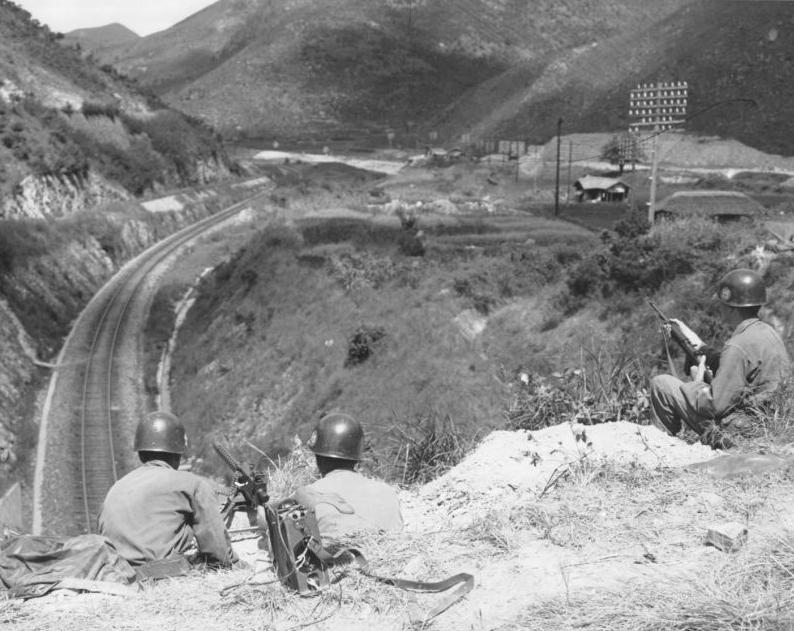
Troops of Co. B, 519th Military
Police Battalion in position above a railway tunnel with
a .30 caliber air-cooled machine gun.
United States Army
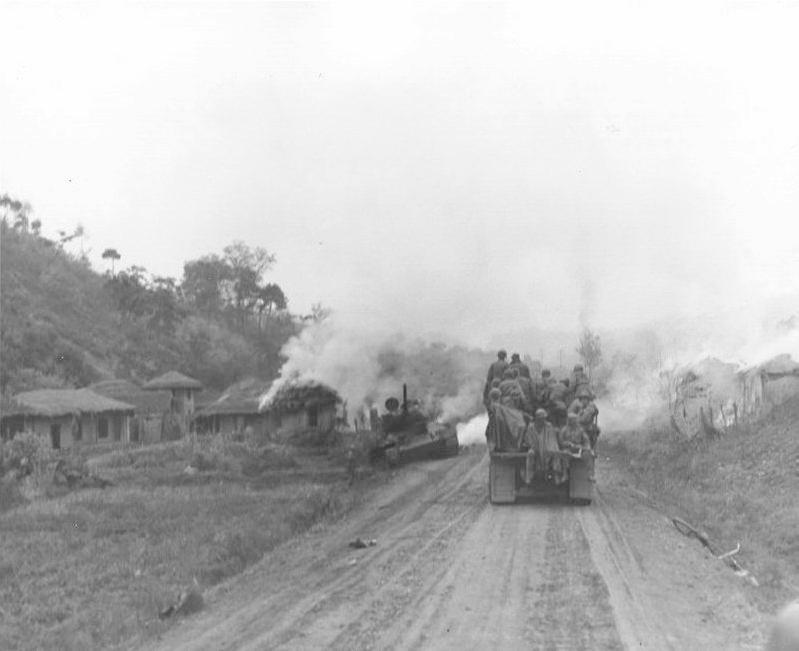
Men of the 5th Cavalry Regiment,
1st Cavalry Division, pass burning buildings and knocked-out tanks of the North Koreans
as they advance to the front in Pyongyang.
United States Army
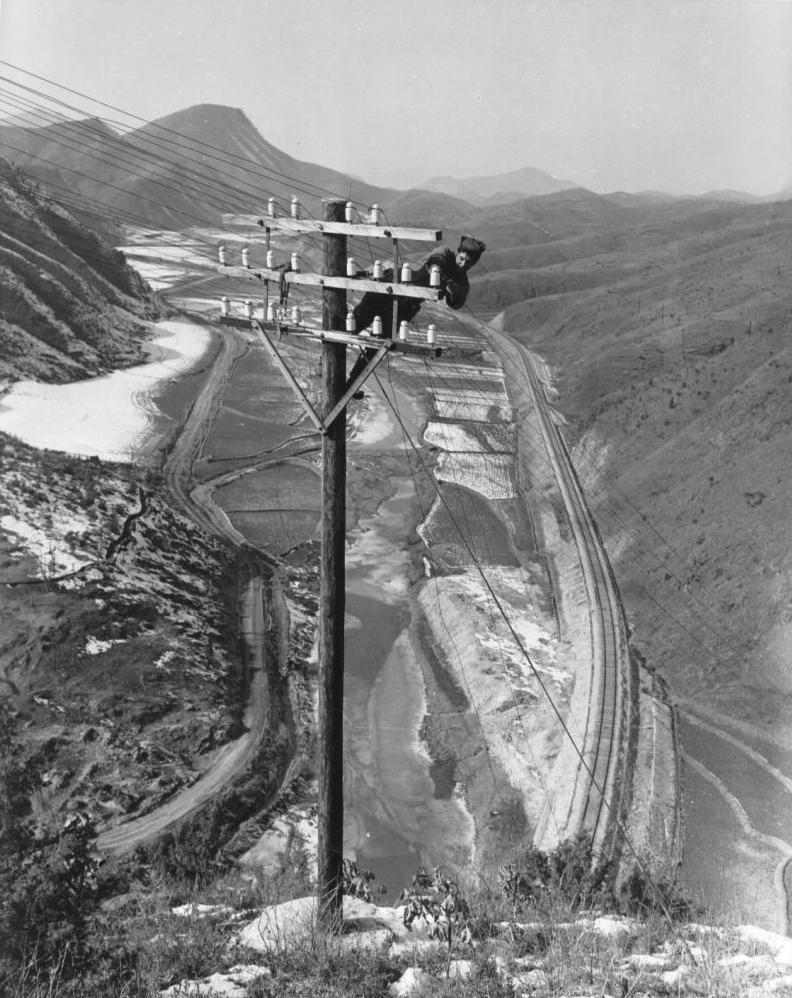
Cpl. Elmer Soprano, First
Platoon, Company A, 4th Signal Battalion. leans over a cliff to
fasten
a jumper, as they rehabilitate lines
from Tanyang to Chechon, Korea.
United States Army
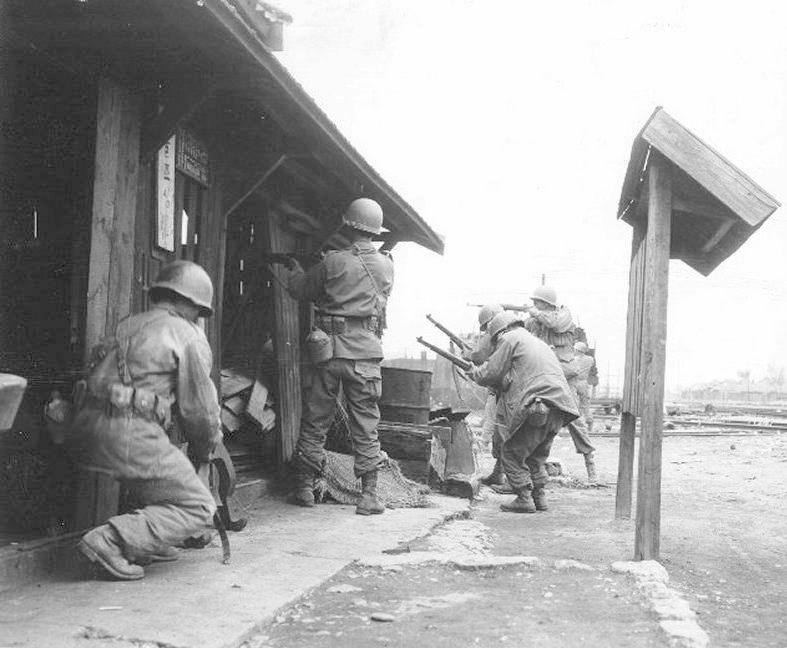 Men of the 1st Cav Division
fighting in a train yard in Pyongyang, Korea.
Men of the 1st Cav Division
fighting in a train yard in Pyongyang, Korea.
United States Army
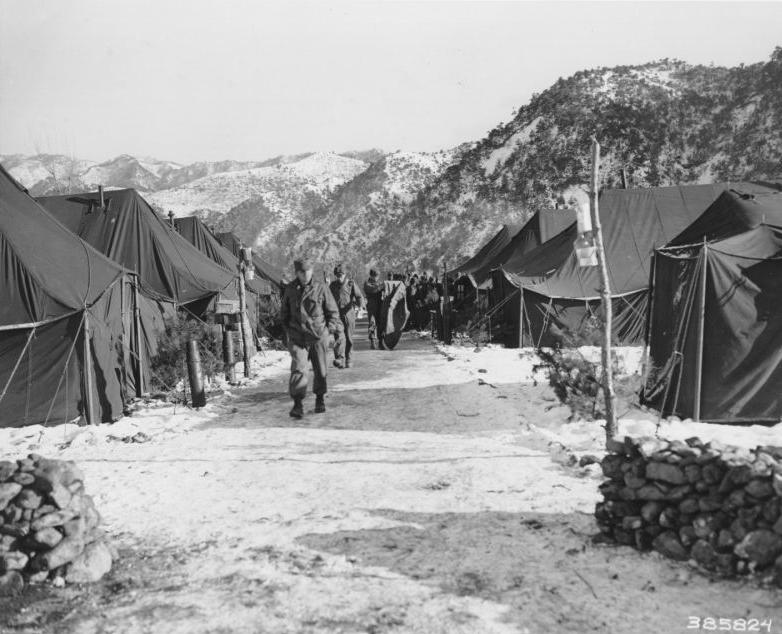 The company street of Co.
K, 31st Inf. Regt., 7th US Inf Div.
The company street of Co.
K, 31st Inf. Regt., 7th US Inf Div.
United States Army
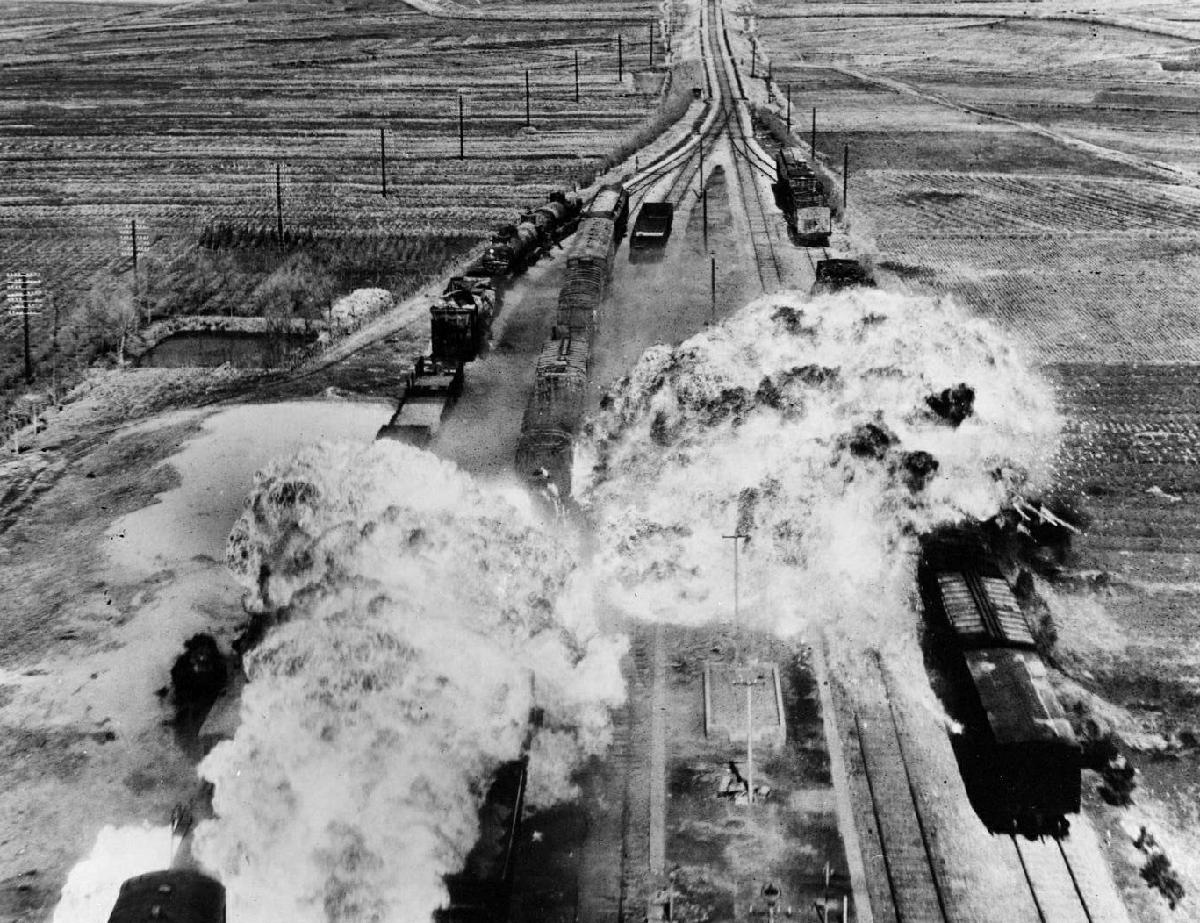 U.S. forces target rail cars
south of Wonsan, North Korea, an east coast port city.
U.S. forces target rail cars
south of Wonsan, North Korea, an east coast port city.
U.S. Army Military History
Institute
But this is war – like any
other – filled with tragedy
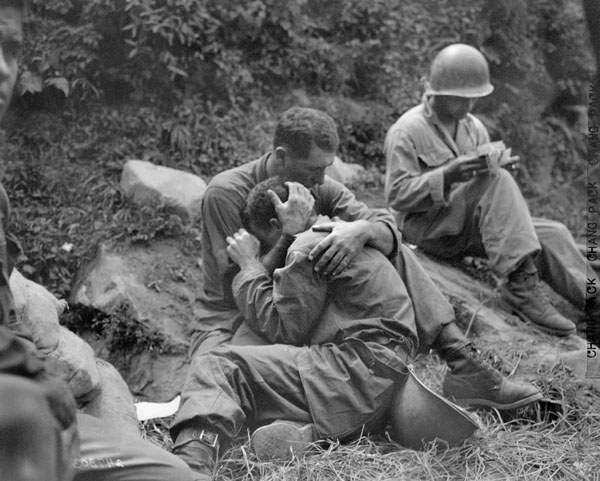
"A grief stricken American
infantryman whose buddy has been killed in action is
comforted by another soldier.
In the background a corpsman methodically fills out casualty tags, Haktong-ni
area Korea."
By Sfc. Al Chang, August
28, 1950
National Archives
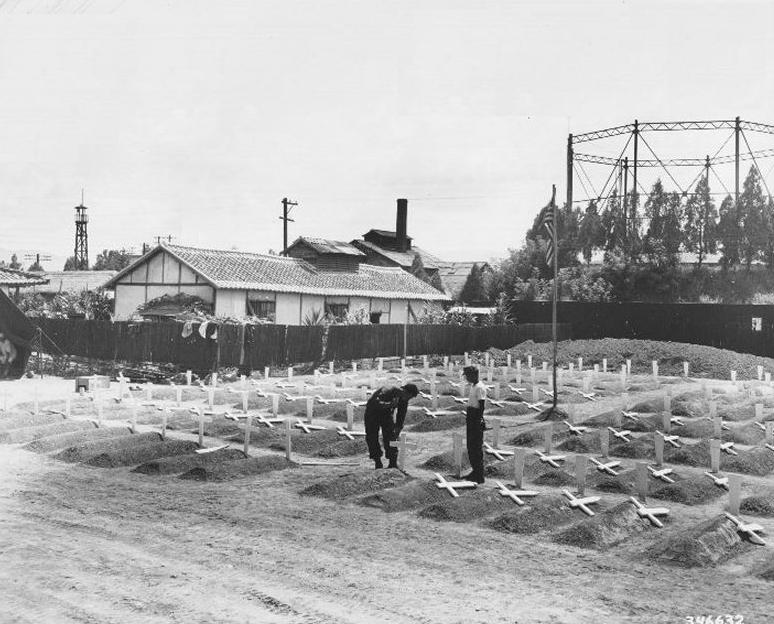
Men replace plain headboards
with crosses on graves in the 1st Cavalry Division
Temporary Cemetery, Taegu, Korea, 25 Aug
1950.
United States Army
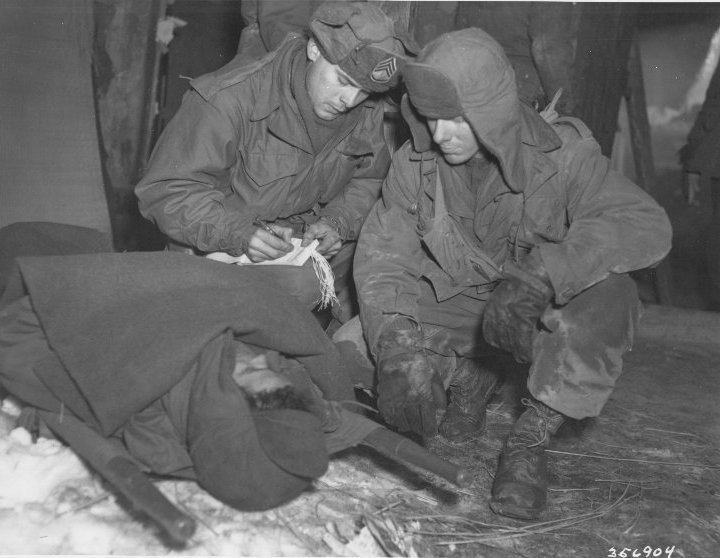
Medical Co, 8th Cav Regt,
1st Cav Div-SGT E. O'Brien fills out tag to attached to a litter, while Charles Sutton comforts
a wounded man who will be sent from this medical aid station near
Yangzi, Korea, to a collection station further to the rear.
United States Army
|
Problems with the Chinese … and with MacArthur
Now
the hero MacArthur spoke to an adoring press about the need to move
even across the North Korean border into China … in order to capture
the bases in China that had been supporting the North Korean
effort. Truman was upset because, in the larger context of the
Cold War which was going on back in Europe, he did not want to invite a
military conflict with the Chinese. But MacArthur answered back
that he was certain that, lacking proper air cover, the Chinese would
never dare to take on the U.N. forces. In this MacArthur proved
to be totally blind and dead wrong.
As the U.N. forces headed north towards the North Korean border with
China, Chinese "volunteer" troops began to be encountered … at first in
small numbers and then further north in larger numbers until finally at
the frozen Chosin Reservoir 30,000 American troops encountered some
120,000 Chinese troops – and a deadly winter – that stopped the
American advance … in fact forced it into retreat – with half of those
American troops being killed or wounded in the process. By
mid-December the American forces had fallen all the way back to the
38th parallel … and China had set Kim aside in order to take command of
the Communist forces in the North. |
In late 1950 Chinese "volunteer" troops
(some 3000,000 of them) come charging cross the border into Korea. Suddenly it is an entirely
different game
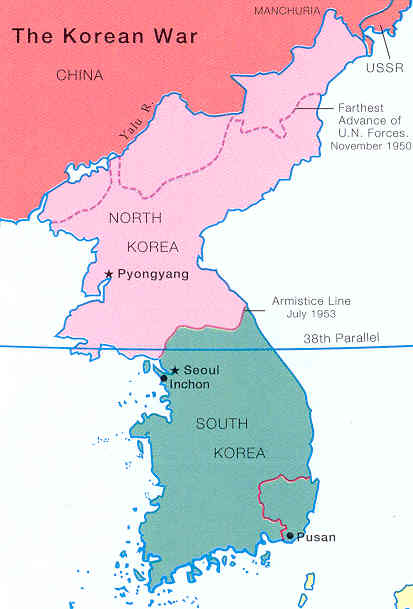
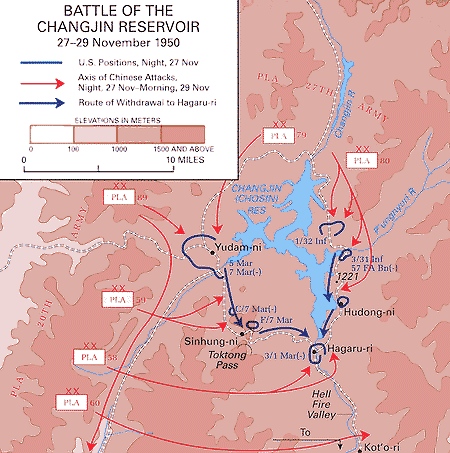
The battle of the Changjin
or 'Chosin' Reservoir - late November 1950
Wikipedia - "Korean
War"
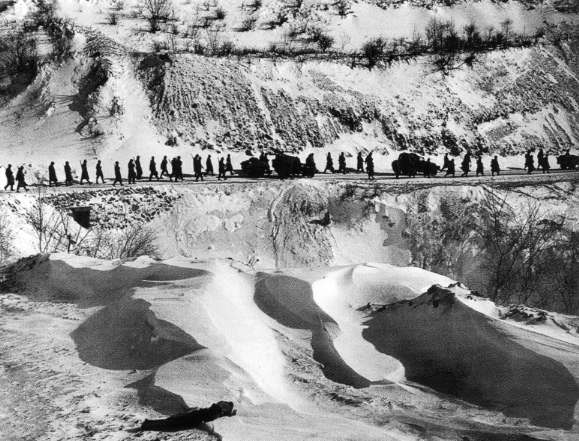 GIs retreating before an
on-slaught of Chinese "volunteers" in North Korea
GIs retreating before an
on-slaught of Chinese "volunteers" in North Korea
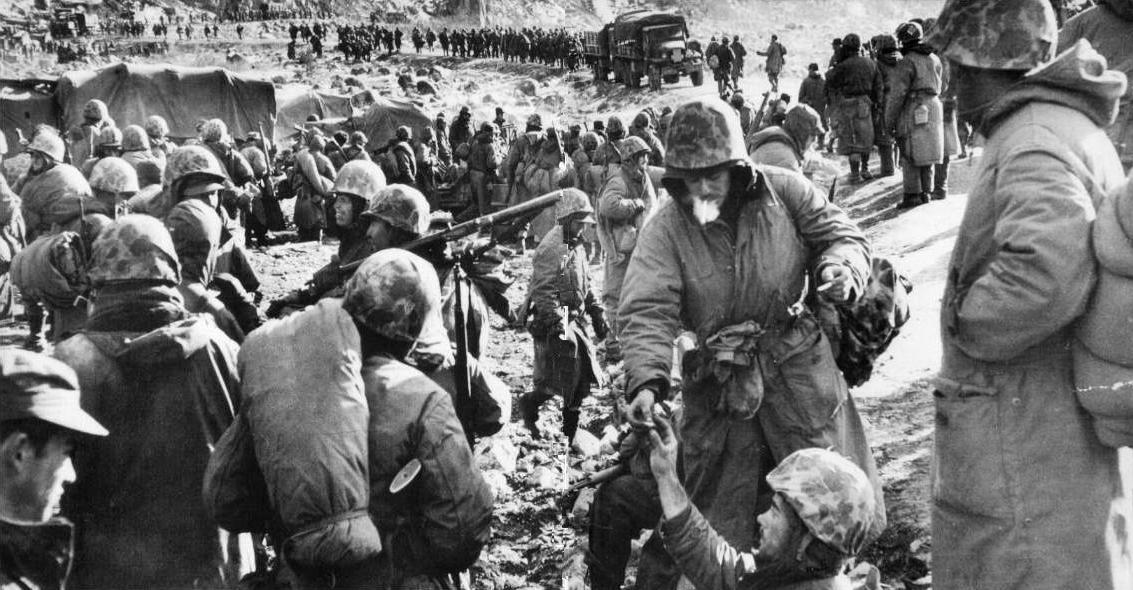
Marines retreating from the
Chosin Reservoir in sub-zero weather
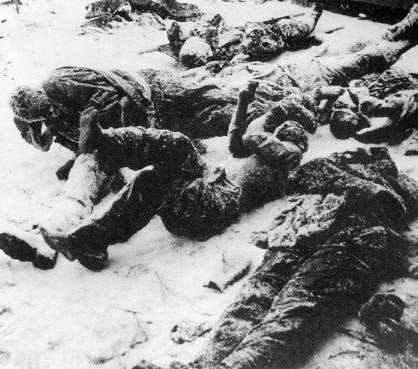
Marine dead brought back
from the fighting in the Chosin Reservoir area
National Archives
NA-127-GK-197-A5348
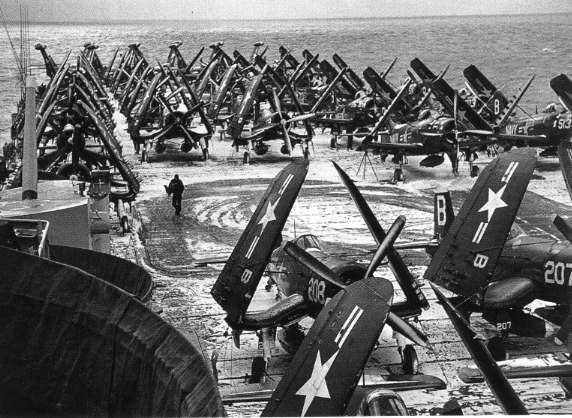 American aircraft aboard
a snow-covered aircraft carrier -
stymied by the Soviet MiG-15
fighter jet
American aircraft aboard
a snow-covered aircraft carrier -
stymied by the Soviet MiG-15
fighter jet
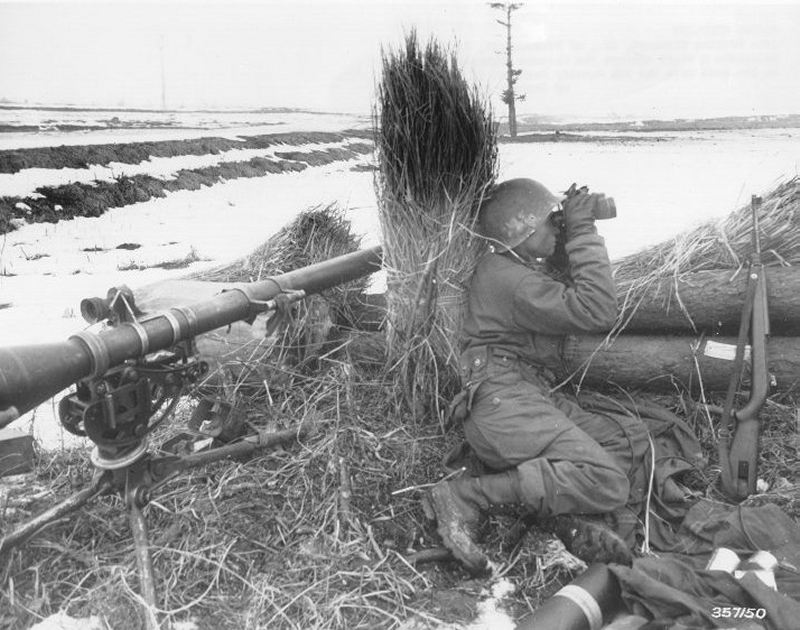
PFC William Stinnett Jr.,
Stevensport, Ky, maintains a vigil against the Chinese Communists
at his post with the 5th Cavalry Regiment in Korea.
United States Army
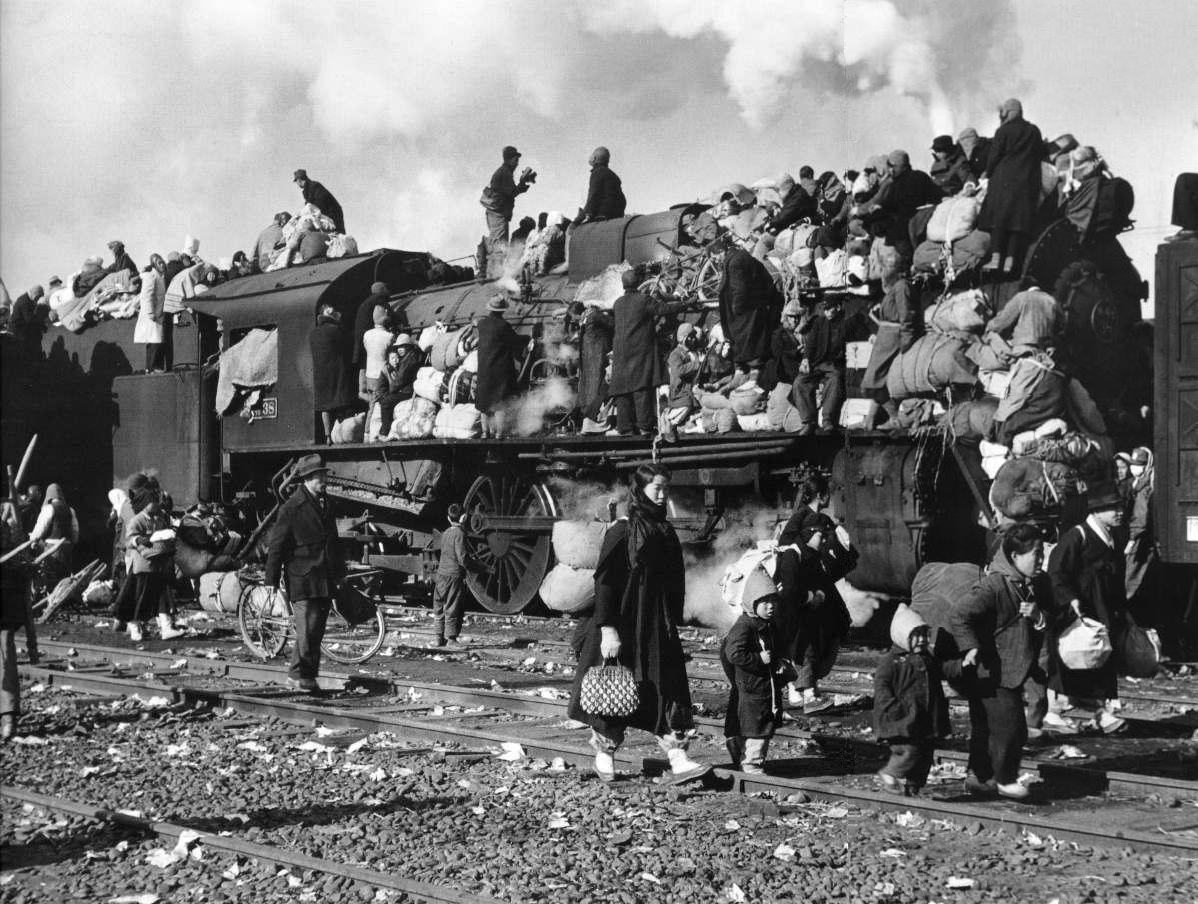
Koreans fleeing the fighting
in 1951
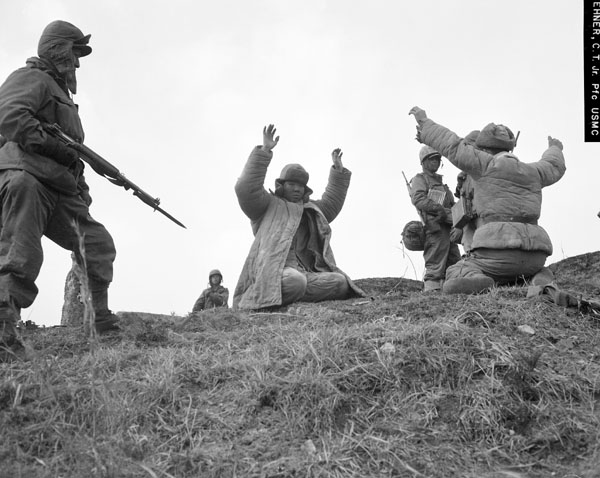
"Men of the 1st Marine Division
capture Chinese Communists during fighting on the central Korean front.
Hoengsong."
By Pfc. C.T. Wehner, March
2, 1951
National Archives
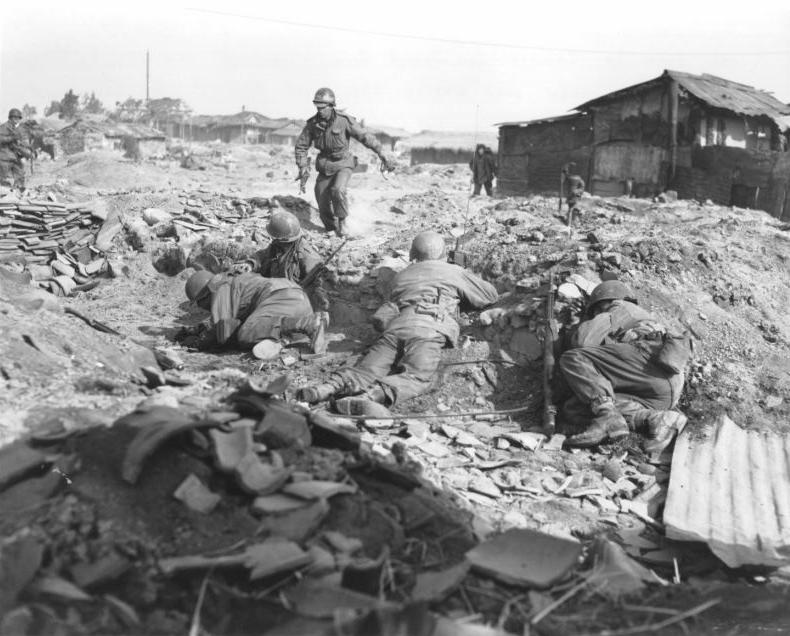
Pinned down by Chinese
Communist
fire, men of the 15th RCT, 3rd Inf Div, take over during the drive against the Communist forces
near the 38th parallel. 23 March 1951
United States Army
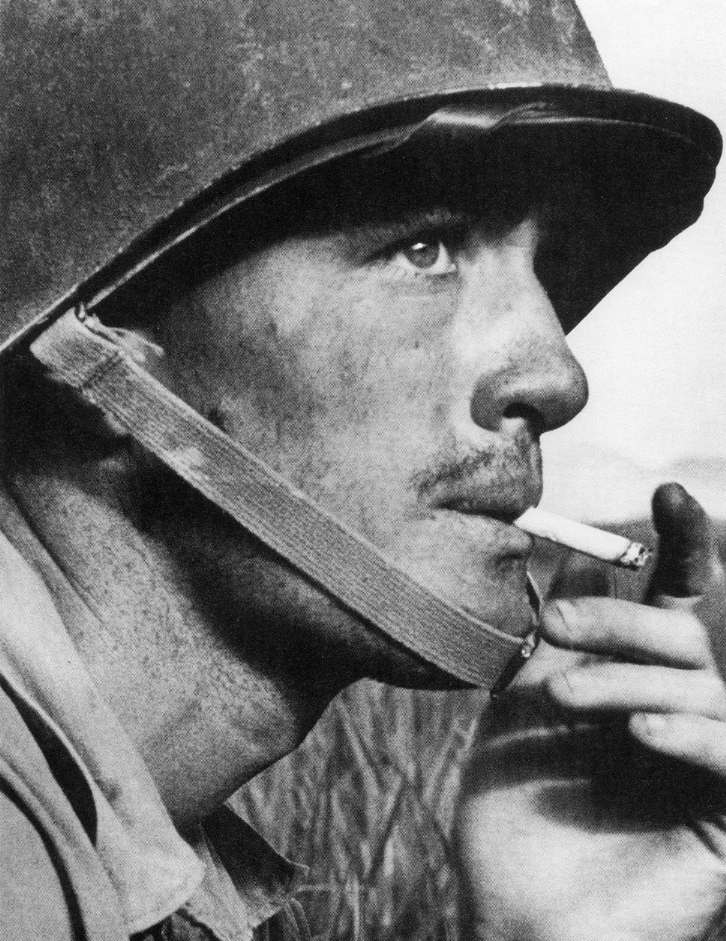
A wearied
Marine
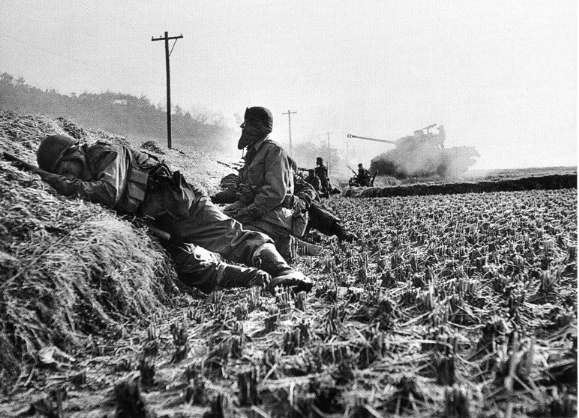 GIs pinned down by enemy
fire near Anyang
GIs pinned down by enemy
fire near Anyang
Then
as the battle swung back and forth along the 38th parallel (Seoul taken
and retaken by both sides) MacArthur ignored Truman by seemingly taking
command of the entire military operation … talking openly to the press
about taking the war to China itself ... even using atomic weapons if
necessary. Tragically MacArthur was again blinded by the fact
that Asia – not Europe – was the only world that he really knew … and
that brought his full devotion.
But Truman was U.S. President – not MacArthur. And with MacArthur
ignoring Truman's efforts to get him to back down (it was even Truman
who had to fly to meet MacArthur rather than MacArthur coming to Truman
to confer over this matter) finally Truman simply relieved MacArthur
from command … knowing what this would do to himself politically in
firing the new American military hero MacArthur.4 But it had to be
done. America could not afford to divide its forces in conducting
its side of the Cold War. And defending Europe – not starting a
war with China – was what America needed to stay focused on.
4Because
of this action, many Americans came to view Truman as a coward, if not
almost a traitor. But a Congressional investigation ultimately
concluded that Truman had indeed acted constitutionally, and correctly,
and that MacArthur (who actually spent all his time in Tokyo) was out
of touch with the military realities in Korea, as well as the critical
challenges facing America in the rest of the world.
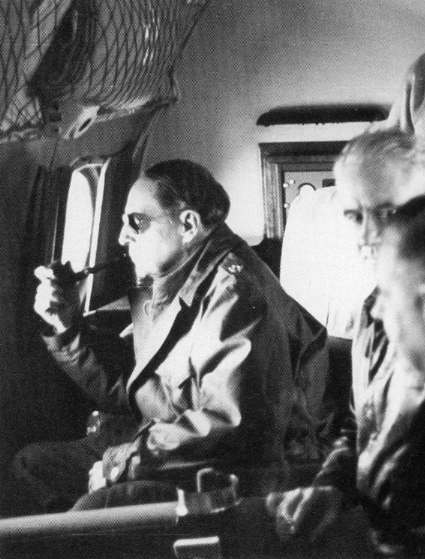
MacArthur looking over North
Korea along the Yalu River border with China as the US offensive
reaches that
border - November 24, 1950. But somehow he failed to detect the 300,000
Chinese
below gathering to counterattack the Americans
National Archives
NA-111-SC-352944
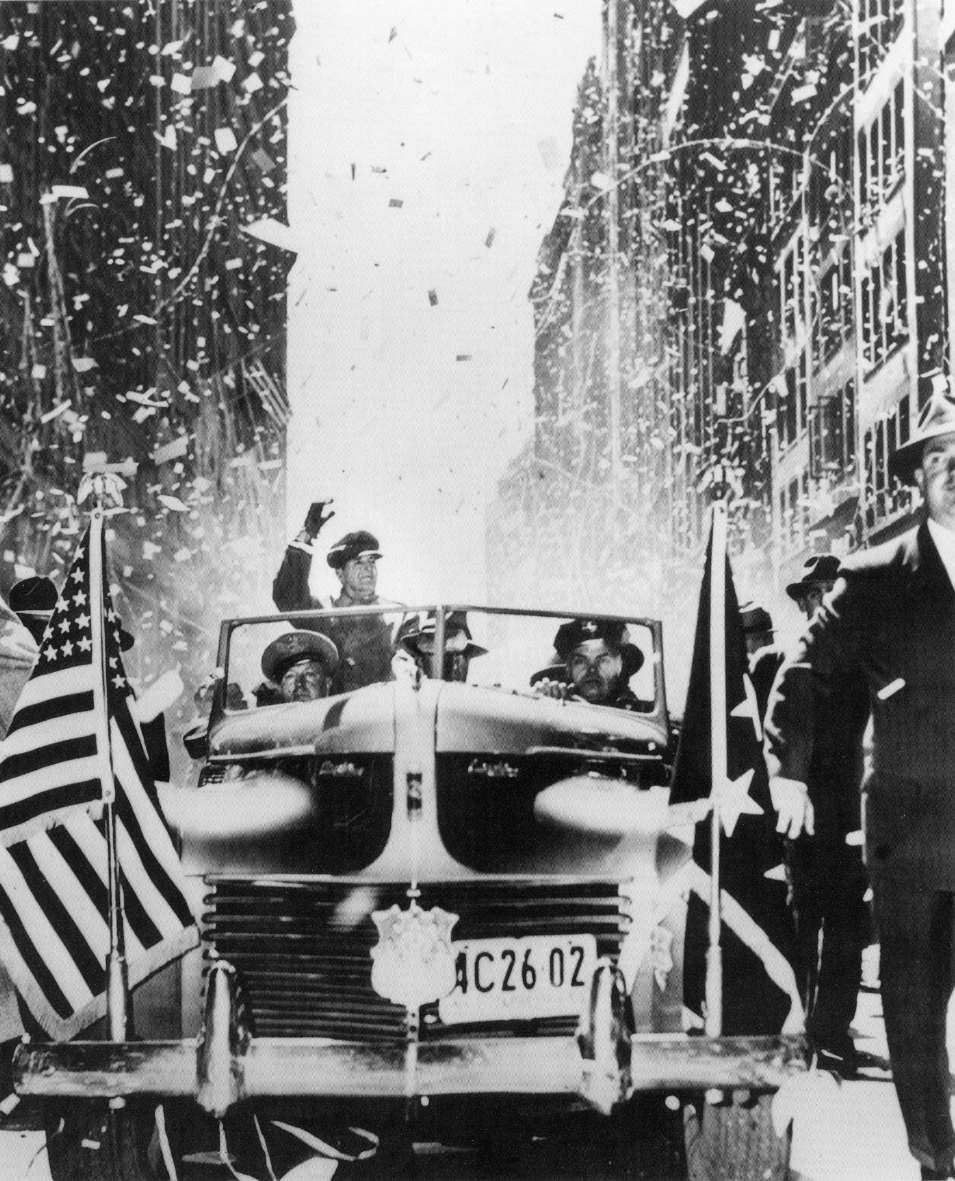
After being relieved of command (April 10, 1951) MacArthur returns to the states
... receiving a hero's
welcome in New York City (7 million turned out to cheer him).
But Congress understood the matter better than the average American
... and backed Truman on his decision
A stalemated war drags on
| Thankfully,
the effort of some 700,000 Chinese troops to take on the U.N. forces at
the 38th parallel the next April (1951) moved very little of the line
of battle separating the two halves of the country. Huge numbers
of Chinese troops were lost (death in battle, disease and
desertion). Thus a stalemate set in … one not likely to be moved
by further military action – action by either side.
|
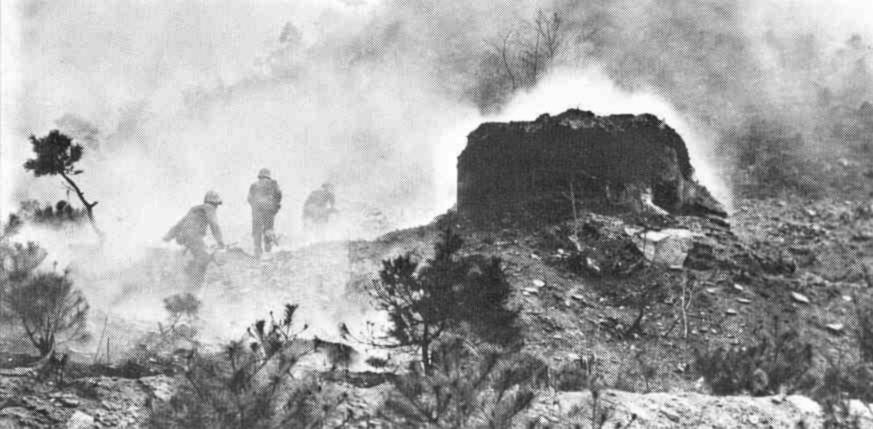
U.S. Troops advance on
Communist
forces in Korea – June 1951
Library of
Congress
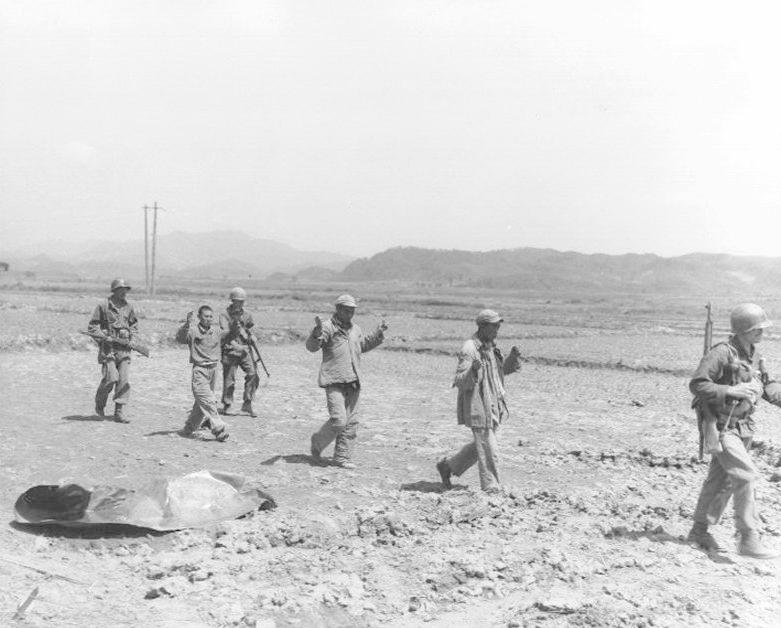 Men of the US 1st Cavalry
Division bring in Chinese Communist captives, north of the Imjin River,
Korea, June 1951.
Men of the US 1st Cavalry
Division bring in Chinese Communist captives, north of the Imjin River,
Korea, June 1951.
United States Army
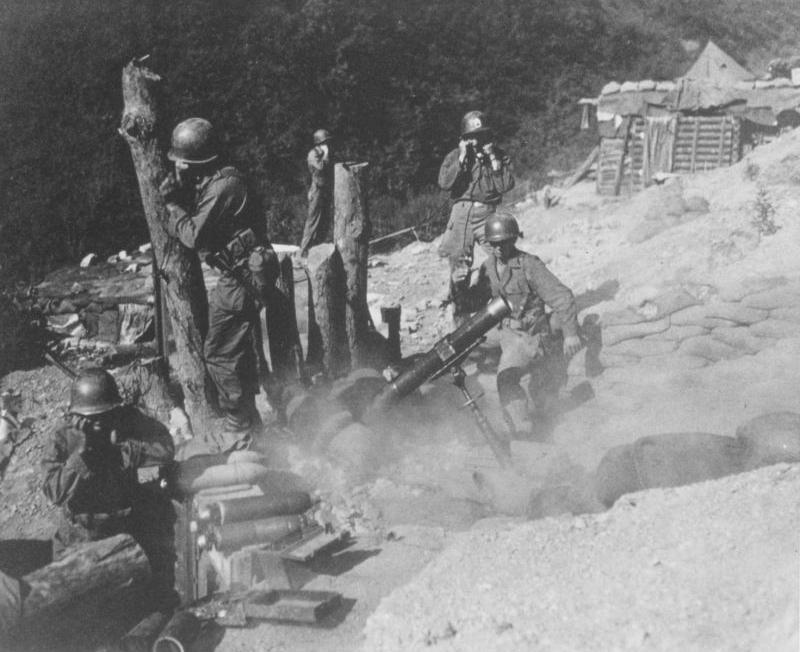 American troops secure a
mountain top with mortar fire somewhere in Korea.
American troops secure a
mountain top with mortar fire somewhere in Korea.
United States Army
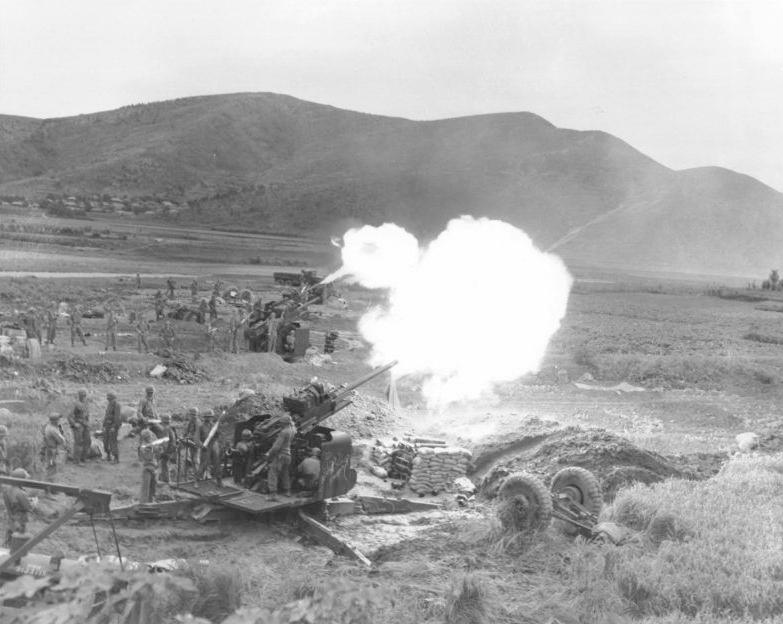
Members of the 68th Battalion,
Division Artillery attached to the 1st ROK Div.,
fire their 90mm antiaircraft
guns.
United States Army
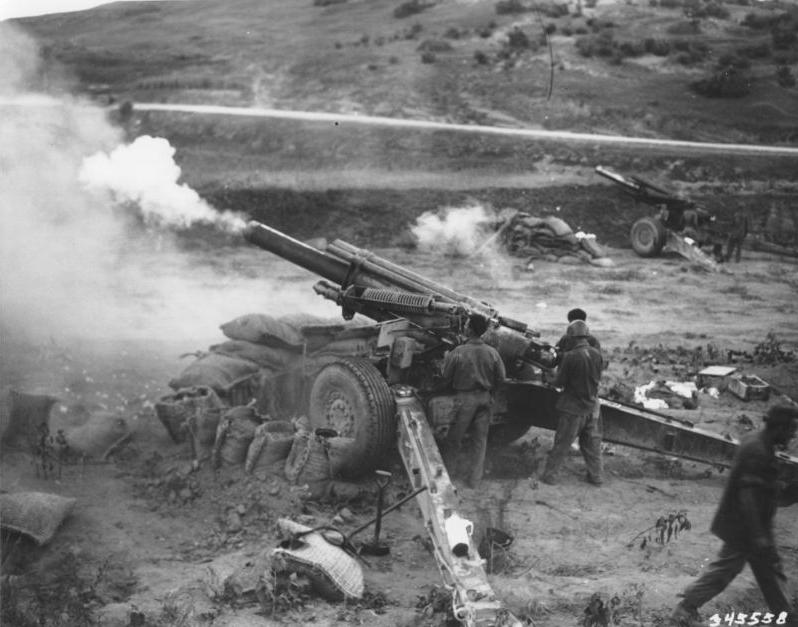 Artillerymen of the 24th
Infantry Div fire 155mm howitzers at dusk, Korea.
Artillerymen of the 24th
Infantry Div fire 155mm howitzers at dusk, Korea.
United States Army
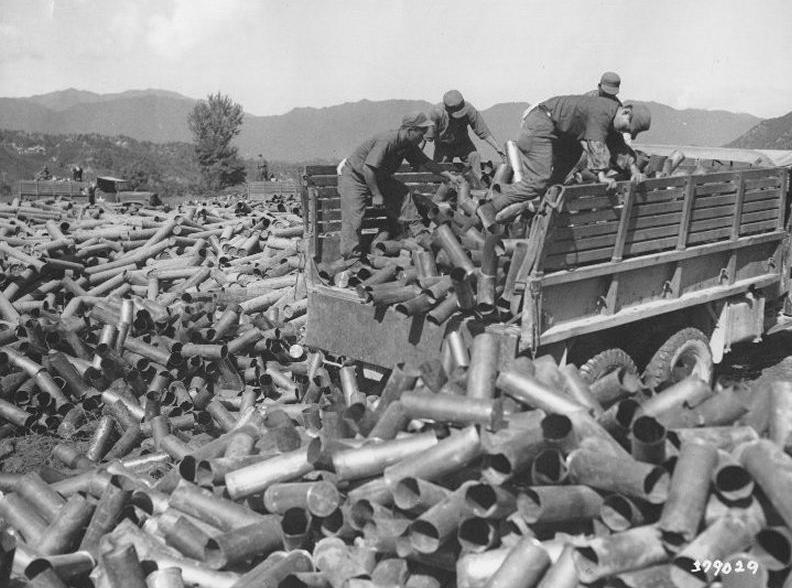
Koreans unload empty shell
casings from a truck at the 2nd Infantry Division Ordnance
Salvage Dump, where they will be salvaged
for reuse, 6 September 1951.
United States Army
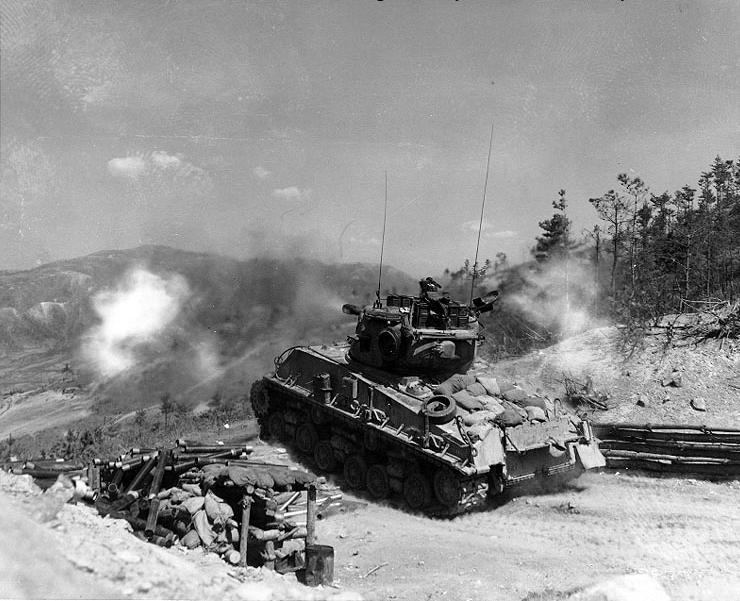
M4A3E8 "Sherman" Tank of
Company B, 72nd Tank Battalion, 2nd Infantry Division, fires its 76mm gun at enemy
bunkers on "Napalm Ridge", in support of the 8th ROK Division. Photograph is dated 11 May
1952.
U.S. National Archives
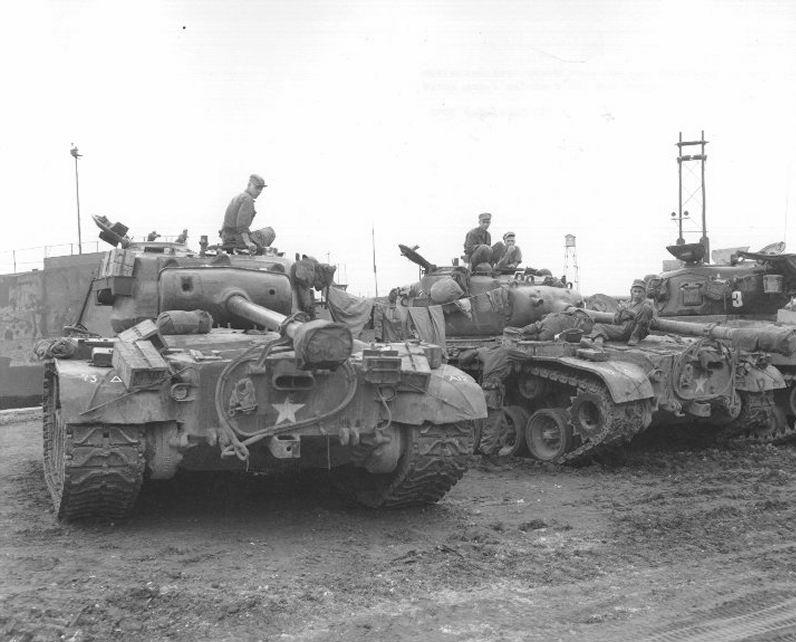
Men and Pershing Tanks of
the 73rd Heavy Tank Battalion await orders to board the
LST's at the Pusan Docks, Korea.
Armistice
Now
faced with this obvious military stalemate, in July of 1951, U.N.
representatives met with Chinese and North Korean representatives at
the city of Panmunjom located near the line of battle … to begin
discussions about a possible armistice.
But the discussions dragged on for two more years … as each side could
not completely give up the idea of gaining some advantage with a bit
more fighting along the battle front. But again, as clearly
nothing much was developing, finally in July of 1953 both parties came
to an armistice agreement establishing a demilitarized zone (DMZ) along
roughly the same 38th parallel … a DMZ still separating the two Koreas
to this very day.
|
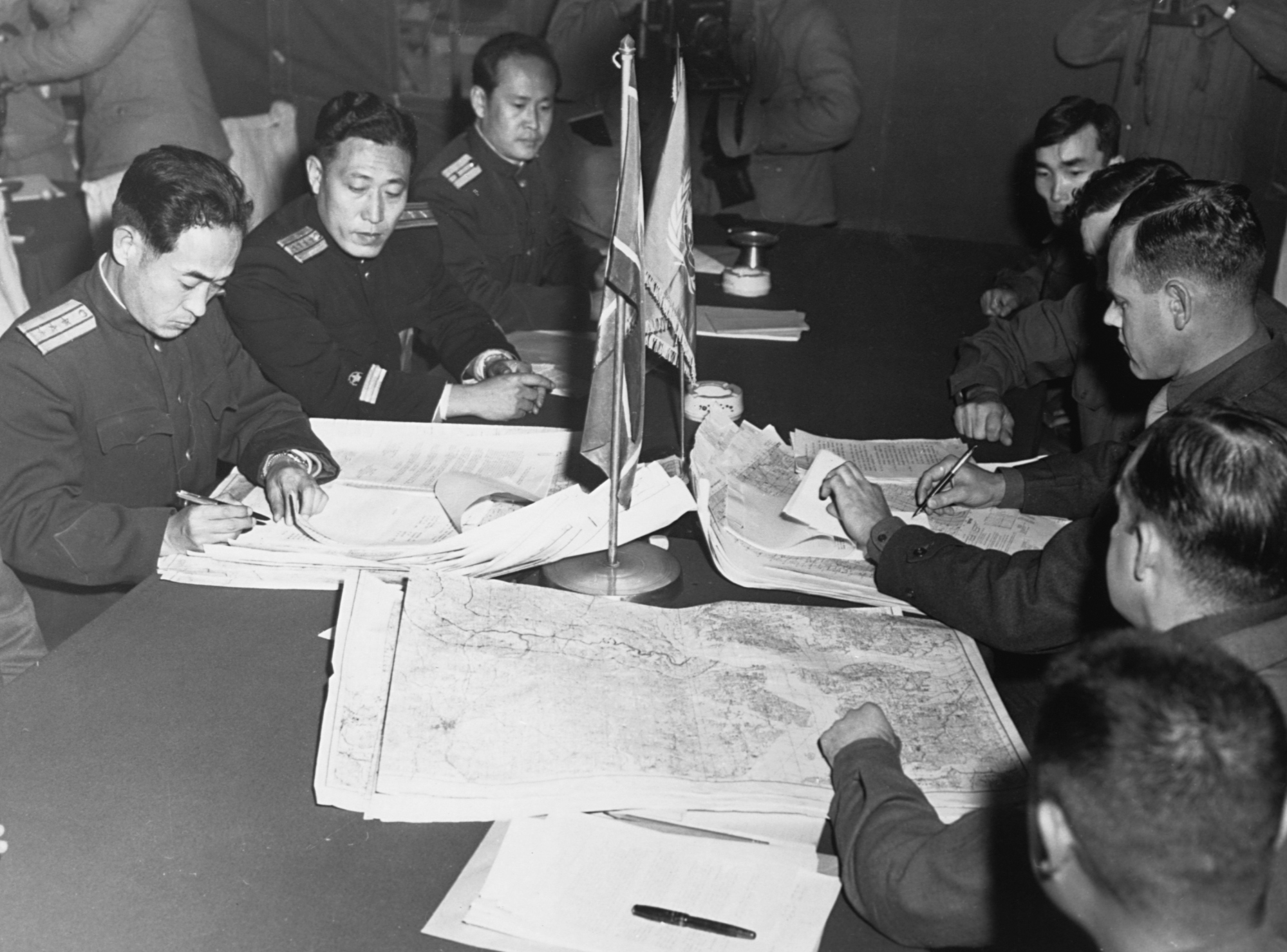
Early discussions (October 1951) concerning an Armistice ... but nothing was ultimately decided
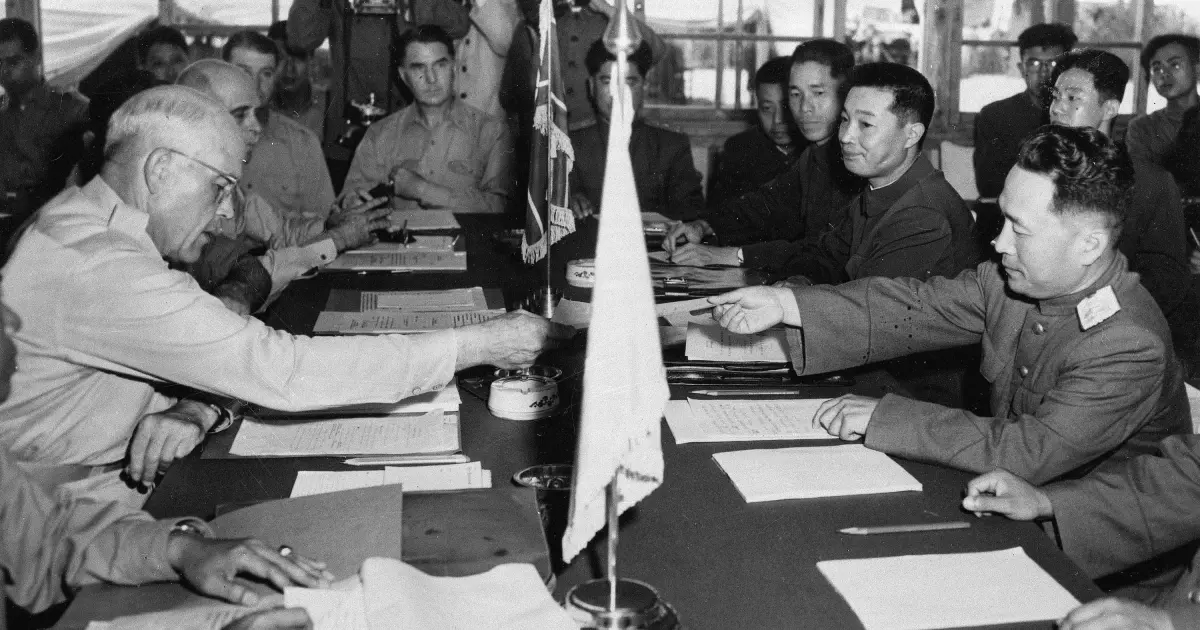
Meeting at Panmunjom 28 July 1953 between US Army General Blackshear M. Bryan
and North Korean General Lee Sang Cho the day after the Armistice finally went into effect
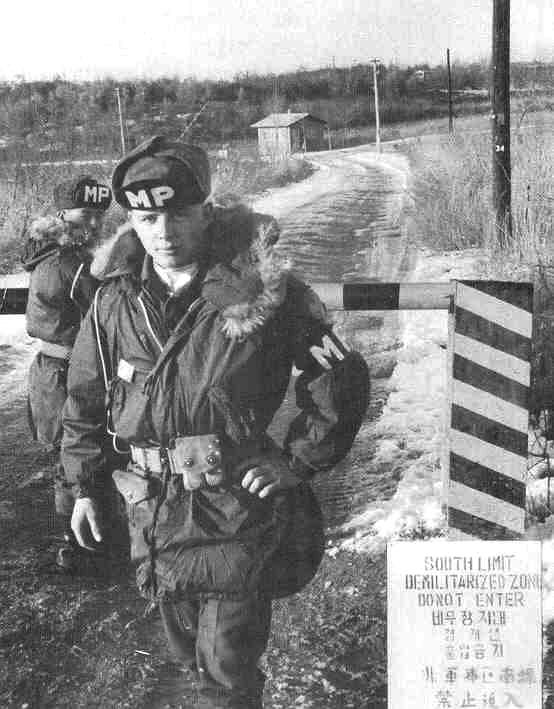 U.N. troops at the Korean
De-Militarized Zone (DMZ)
U.N. troops at the Korean
De-Militarized Zone (DMZ)
| | | | |


 The Berlin Blockade (1948-1949)
The Berlin Blockade (1948-1949)





































































 U.N. troops at the Korean
De-Militarized Zone (DMZ)
U.N. troops at the Korean
De-Militarized Zone (DMZ)
